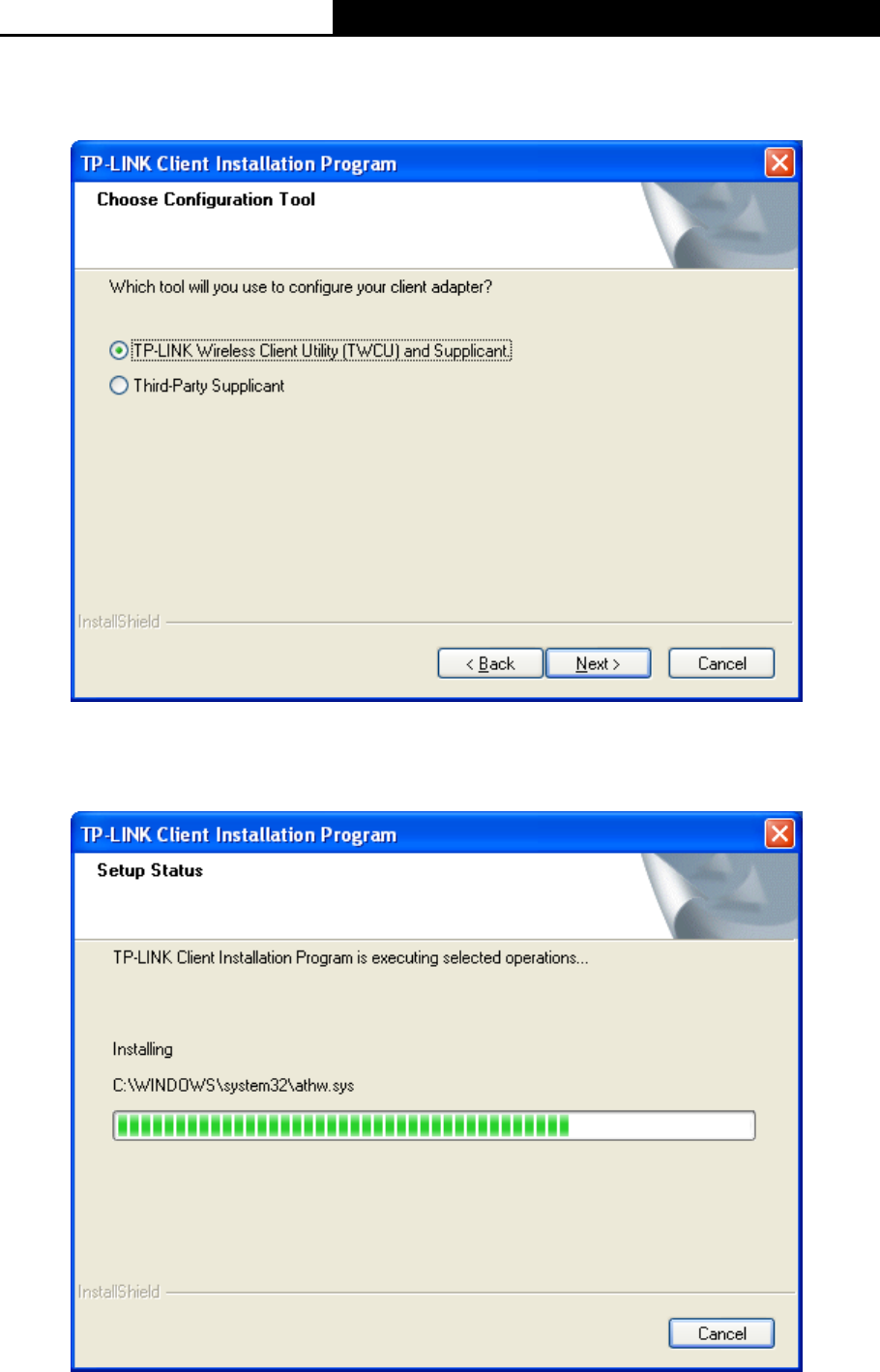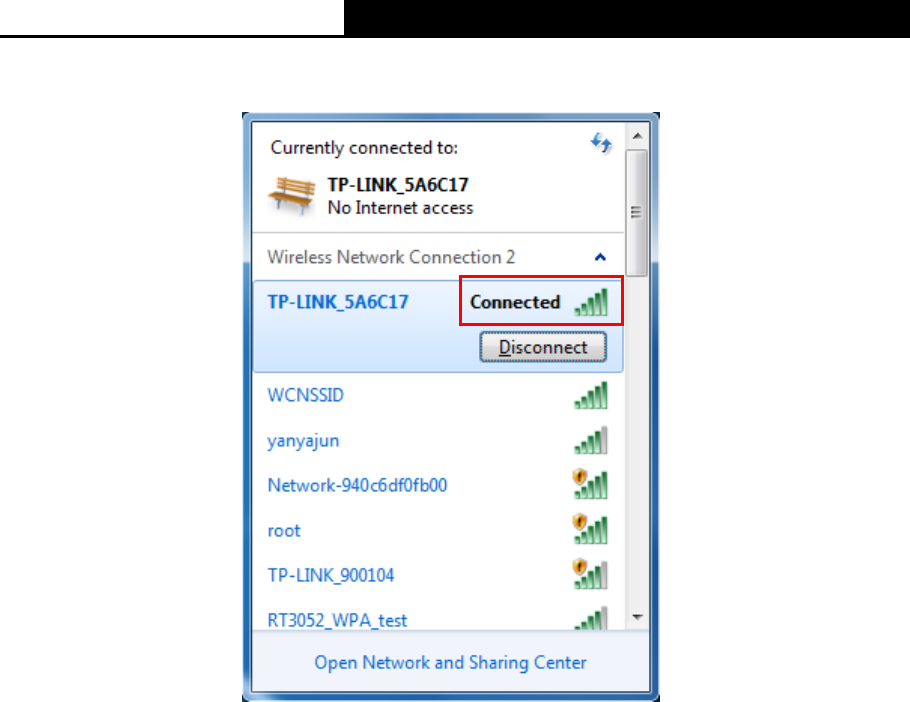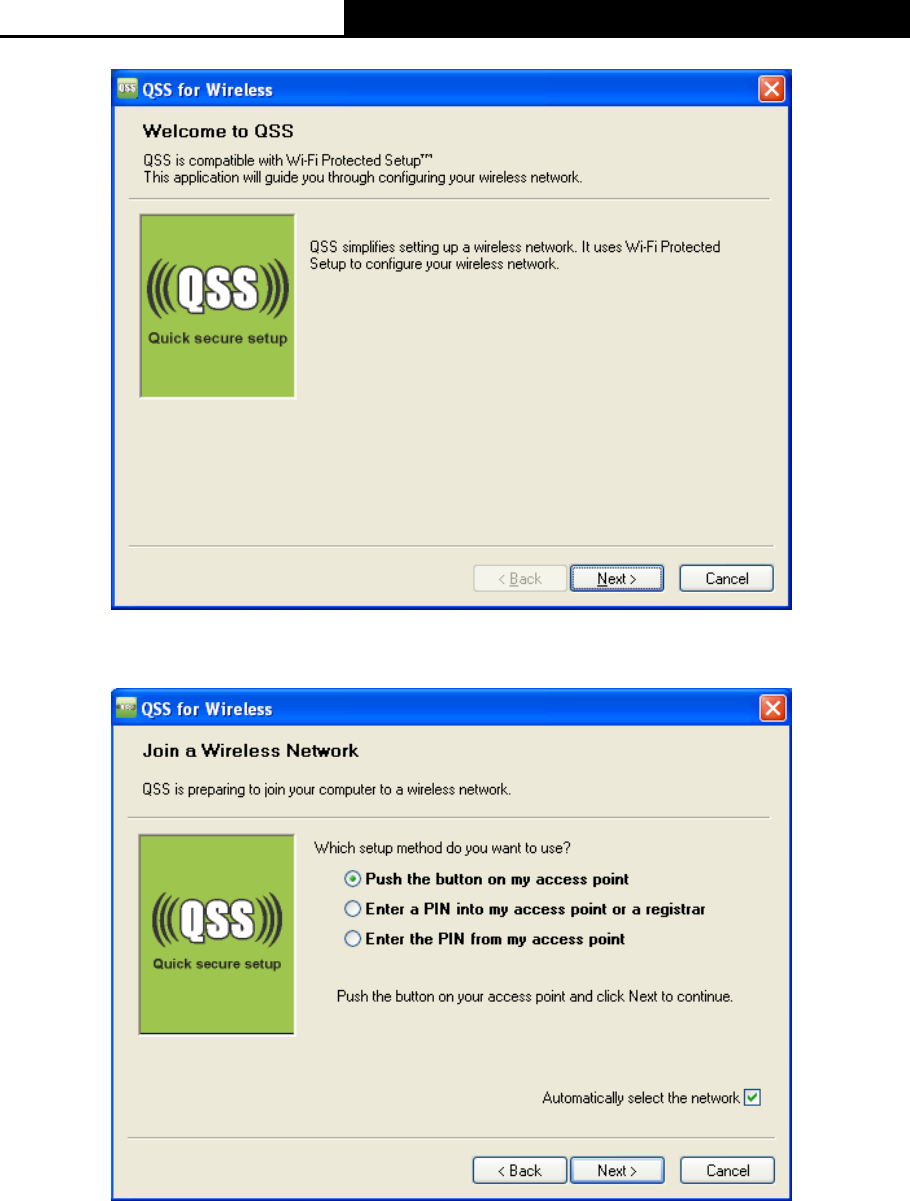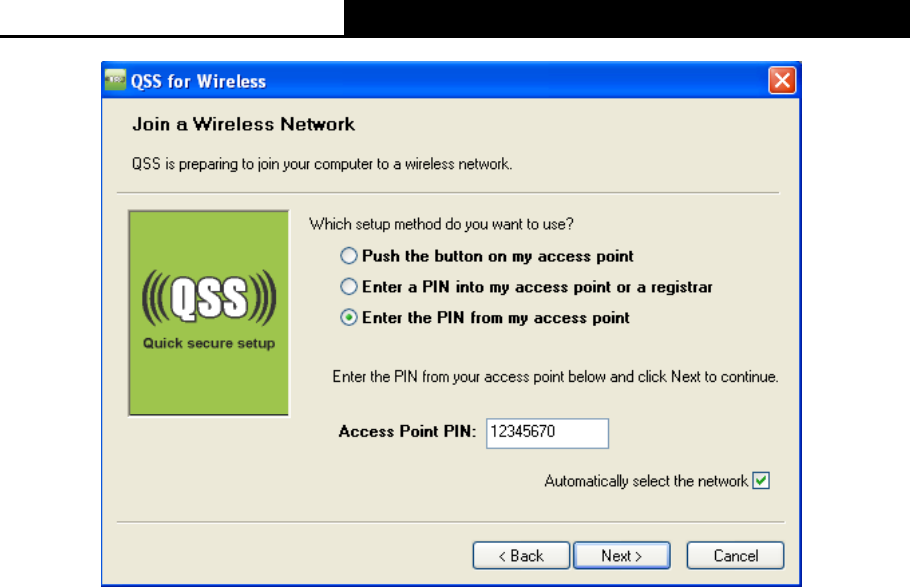TP Link Technologies WDN4800 450Mbps Wireless N Dual Band PCI Express Adapter User Manual UserMan FCC
TP-Link Technologies Co., Ltd. 450Mbps Wireless N Dual Band PCI Express Adapter UserMan FCC
Contents
- 1. User's manual-FCC_rev
- 2. UserMan-FCC
UserMan-FCC
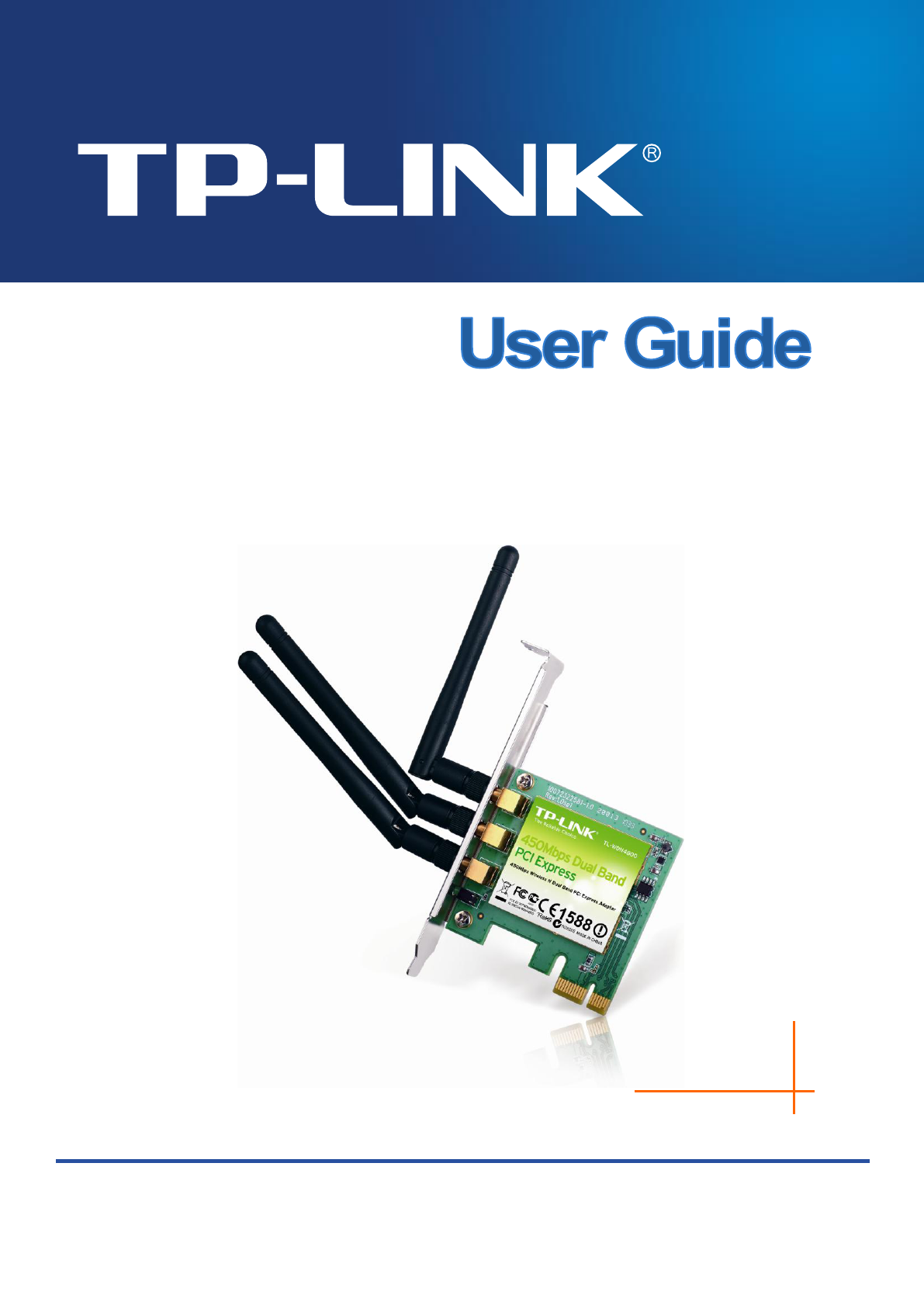
TL-WDN4800
450Mbps Wireless N Dual Band PCI Express Adapter
Rev: 1.1.2
1910010665

COPYRIGHT & TRADEMARKS
Specifications are subject to change without notice. is a registered trademark
of TP-LINK TECHNOLOGIES CO., LTD. Other brands and product names are trademarks or
registered trademarks of their respective holders.
No part of the specifications may be reproduced in any form or by any means or used to make any
derivative such as translation, transformation, or adaptation without permission from TP-LINK
TECHNOLOGIES CO., LTD. Copyright © 2012 TP-LINK TECHNOLOGIES CO., LTD. All rights
reserved.
http://www.tp-link.com
FCC STATEMENT
This equipment has been tested and found to comply with the limits for a Class B digital device,
pursuant to part 15 of the FCC Rules. These limits are designed to provide reasonable protection
against harmful interference in a residential installation. This equipment generates, uses and can
radiate radio frequency energy and, if not installed and used in accordance with the instructions,
may cause harmful interference to radio communications. However, there is no guarantee that
interference will not occur in a particular installation. If this equipment does cause harmful
interference to radio or television reception, which can be determined by turning the equipment off
and on, the user is encouraged to try to correct the interference by one or more of the following
measures:
Reorient or relocate the receiving antenna.
Increase the separation between the equipment and receiver.
Connect the equipment into an outlet on a circuit different from that to which the receiver
is connected.
Consult the dealer or an experienced radio/ TV technician for help.
This device complies with part 15 of the FCC Rules. Operation is subject to the following two
conditions:
1) This device may not cause harmful interference.
2) This device must accept any interference received, including interference that may
cause undesired operation.
Any changes or modifications not expressly approved by the party responsible for compliance
could void the user’s authority to operate the equipment.

Note: The manufacturer is not responsible for any radio or TV interference caused by
unauthorized modifications to this equipment. Such modifications could void the user’s authority
to operate the equipment.
Operations in the 5.15-5.25GHz band are restricted to indoor usage only.
Note: The country code selection is for non-US model only and is not available to all US model.
Per FCC regulation, all WiFi product marketed in US must fixed to US operation channels only.
FCC RF Radiation Exposure Statement:
This equipment complies with FCC RF radiation exposure limits set forth for an uncontrolled
environment. This device and its antenna must not be co-located or operating in conjunction with
any other antenna or transmitter.
“To comply with FCC RF exposure compliance requirements, this grant is applicable to only
Mobile Configurations. The antennas used for this transmitter must be installed to provide a
separation distance of at least 20 cm from all persons and must not be co-located or operating in
conjunction with any other antenna or transmitter.”
CE Mark Warning
This is a class B product. In a domestic environment, this product may cause radio interference, in
which case the user may be required to take adequate measures.
National Restrictions
This device is intended for home and office use in all EU countries (and other countries following
the EU directive 1999/5/EC) without any limitation except for the countries mentioned below:
Country
Restriction
Reason/remark
Bulgaria
None
General authorization required for outdoor use and
public service
France
Outdoor use limited to
10 mW e.i.r.p. within
the band 2454-2483.5
MHz
Military Radiolocation use. Refarming of the 2.4 GHz
band has been ongoing in recent years to allow current
relaxed regulation. Full implementation planned 2012
Italy
None
If used outside of own premises, general authorization is
required

Luxembourg
None
General authorization required for network and service
supply(not for spectrum)
Norway
Implemented
This subsection does not apply for the geographical area
within a radius of 20 km from the centre of Ny-Ålesund
Russian Federation
None
Only for indoor applications
Note: Please don’t use the product outdoors in France.
Industry Canada Statement:
This device complies with RSS-210 of the Industry Canada Rules. Operation is subject to the
following two conditions:
(1)This device may not cause harmful interference, and
(2)This device must accept any interference received, including interference that may cause
undesired operation.
IMPORTANT NOTE:
Radiation Exposure Statement:
This equipment complies with Canada radiation exposure limits set forth for an uncontrolled
environment. This equipment should be installed and operated with minimum distance 20cm
between the radiator & your body.
Ce dispositif est conforme à la norme CNR-210 d’Industrie Canada applicable aux appareils radio
exempts de licence. Son fonctionnement est sujet aux deux conditions suivantes:
(1) Le dispositif ne doit pas produire de brouillage préjudiciable, et
(2) Ce dispositif doit accepter tout brouillage reçu,y compris un brouillage susceptible de
provoquer un fonctionnement indésirable.
NOTE IMPORTANTE:
Déclaration d’exposition aux radiations:
Cet équipement est conforme aux limites d’exposition aux rayonnements IC établies pour un
environnement non contrôlé. Cet équipement doit être installé et utilisé avec un minimum de 20
cm de distance entre la source de rayonnement et votre corps.
Caution :
(i) the device for operation in the band 5150-5250 MHz is only for indoor use to reduce the
potential for harmful interference to co-channel mobile satellite systems;
(ii) the maximum antenna gain permitted for devices in the bands 5250-5350 MHz and 5470-5725
MHz shall comply with the e.i.r.p. limit; and
(iii) the maximum antenna gain permitted for devices in the band 5725-5825 MHz shall comply
with the e.i.r.p. limits specified for point-to-point and non point-to-point operation as appropriate.
(iv) Users should also be advised that high-power radars are allocated as primary users (i.e.
priority users) of the bands 5250-5350 MHz and 5650-5850 MHz and that these radars could
cause interference and/or damage to LE-LAN devices.
Avertissement:
(i) les dispositifs fonctionnant dans la bande 5 150-5 250 MHz sont réservés uniquement pour une
utilisation à l’intérieur afin de réduire les risques de brouillage préjudiciable aux systèmes de
satellites mobiles utilisant les mêmes canaux;
(ii) le gain maximal d’antenne permis pour les dispositifs utilisant les bandes 5 250-5 350 MHz et
5 470-5 725 MHz doit se conformer à la limite de p.i.r.e.;
(iii) le gain maximal d’antenne permis (pour les dispositifs utilisant la bande 5 725-5 825 MHz) doit
se conformer à la limite de p.i.r.e. spécifiée pour l’exploitation point à point et non point à point,
selon le cas.
(iv) De plus, les utilisateurs devraient aussi être avisés que les utilisateurs de radars de haute
puissance sont désignés utilisateurs principaux (c.-à-d., qu’ils ont la priorité) pour les bandes 5
250-5 350 MHz et 5 650-5 850 MHz et que ces radars pourraient causer du brouillage et/ou des
dommages aux dispositifs LAN-EL.
This device has been designed to operate with the antennas listed below, and having a maximum
gain of 2 dBi. Antennas not included in this list or having a gain greater than 2 dBi are strictly
prohibited for use with this device. The required antenna impedance is 50 ohms.
Under Industry Canada regulations, this radio transmitter may only operate using an antenna of a
type and maximum (or lesser) gain approved for the transmitter by Industry Canada. To reduce
potential radio interference to other users, the antenna type and its gain should be so chosen that
the equivalent isotropically radiated power (e.i.r.p.) is not more than that permitted for successful
communication.
This radio transmitter (IC: 8853A-WDN4800 / Model: TL-WDN4800) has been approved by
Industry Canada to operate with the antenna types listed below with the maximum permissible
gain and required antenna impedance for each antenna type indicated. Antenna types not
included in this list, having a gain greater than the maximum gain indicated for that type, are
strictly prohibited for use with this device.
Ce dispositif a été conçu pour fonctionner avec une antenne ayant un gain maximal de 2 dB. Une
antenne à gain plus élevé est strictement interdite par les règlements d'Industrie Canada.
L'impédance d'antenne requise est de 50 ohms.
Conformément à la réglementation d'Industrie Canada, le présent émetteur radio peutfonctionner
avec une antenne d'un type et d'un gain maximal (ou inférieur) approuvé pourl'émetteur par

Industrie Canada. Dans le but de réduire les risques de brouillage radioélectriqueà l'intention des
autres utilisateurs, il faut choisir le type d'antenne et son gain de sorte que lapuissance isotrope
rayonnée équivalente (p.i.r.e.) ne dépasse pas l'intensité nécessaire àl'établissement d'une
communication satisfaisante.
Le présent émetteur radio (IC: 8853A-WDN4800 / Model: TL-WDN4800) a été approuvé par
Industrie Canada pour fonctionner avec les types d'antenne énumérés ci-dessous et ayant un
gain admissible maximal et l'impédance requise pour chaque type d'antenne. Les types d'antenne
non inclus dans cette liste, ou dont le gain est supérieur au gain maximal indiqué, sont strictement
interdits pour l'exploitation de l'émetteur.
Approved antenna(s) list
Type
Gain
Omni
2dBi
Korea Warning Statements:
당해 무선설비는 운용중 전파혼신 가능성이 있음.
NCC Notice:
經型式認證合格之低功率射頻電機,非經許可,公司、商號或使用者均不得擅自變更頻率、加大功
率或變更原設計之特性及功能。
低功率射頻電機之使用不得影響飛航安全及干擾合法通信;經發現有干擾現象時,應立即停用,並
改善至無干擾時方得繼續使用。前項合法通信,指依電信法規定作業之無線電通信。低功率射頻電
機須忍受合法通信或工業、科學及醫療用電波輻射性電機設備之干擾。
Продукт сертифіковано згідно с правилами системи УкрСЕПРО на відповідність вимогам
нормативних документів та вимогам, що передбачені чинними законодавчими актами
України.

TP-LINK TECHNOLOGIES CO., LTD
TP-LINK TECHNOLOGIES CO., LTD.
Building 24 (floors 1, 3, 4, 5), and 28 (floors 1-4) Central Science and Technology Park, Shennan
Rd, Nanshan, Shenzhen, China
DECLARATION OF CONFORMITY
For the following equipment:
Product Description: 450Mbps Wireless N Dual Band PCI Express Adapter
Model No.: TL-WDN4800
Trademark: TP-LINK
We declare under our own responsibility that the above products satisfy all the technical
regulations applicable to the product within the scope of Council Directives:
Directives 1999/5/EC, Directives 2006/95/EC, Directives 1999/519/EC, Directives 2011/65/EU
The above product is in conformity with the following standards or other normative documents:
ETSI EN 300 328 V1.7.1: 2006
ETSI EN 301 489-1 V1.8.1:2008 & ETSI EN 301 489-17 V2.1.1:2009
EN60950-1:2006+A11:2009+A1:2010+A12:2011
EN62311:2008
EN 301 893 V1.5.1:2008
The product carries the CE Mark:
Person is responsible for marking this declaration:
Yang Hongliang
Product Manager of International Business
Date of issue: 2012
CONTENTS
Package Contents .................................................................................................... 1
Chapter 1. Introduction ........................................................................................ 2
1.1 Overview of the product ........................................................................................................ 2
1.2 Features ................................................................................................................................ 2
1.3 LED Status ............................................................................................................................ 3
Chapter 2. Installation Guide ............................................................................... 4
2.1 Hardware Installation ............................................................................................................ 4
2.2 Software Installation .............................................................................................................. 4
Chapter 3. Configuration Guide ......................................................................... 10
3.1 For Windows XP ................................................................................................................. 10
3.1.1 Current Status .............................................................................................................. 10
3.1.2 Profile Management ..................................................................................................... 12
3.1.3 Diagnostics .................................................................................................................. 21
3.2 For Windows Vista .............................................................................................................. 22
3.3 For Windows 7 .................................................................................................................... 24
Chapter 4. QSS Configuration ........................................................................... 27
4.1 PBC (Push Button Configuration) method .......................................................................... 29
4.2 PIN method ......................................................................................................................... 31
4.2.1 Enter a PIN into your AP device .................................................................................. 31
4.2.2 Enter the PIN from your AP device.............................................................................. 32
Appendix A: Specifications ................................................................................... 34
Appendix B: Glossary ............................................................................................ 35

TL-WDN4800
450Mbps Wireless N Dual Band PCI Express Adapter
1
Package Contents
The following contents should be found in your box:
One TL-WDN4800 450Mbps Wireless N Dual Band PCI Express Adapter
Quick Installation Guide
One Resource CD for TL-WDN4800, including:
TP-LINK Wireless Configuration Utility (TWCU) and Drivers
Quick Secure Setup (QSS)
User Guide
Other Helpful Information
Note:
Make sure that the package contains the above items. If any of the listed items is damaged or
missing, please contact with your distributor.
Conventions
The “Adapter” mentioned in this user guide stands for TL-WDN4800 450Mbps Wireless N Dual
Band PCI Express Adapter without any explanations.

TL-WDN4800
450Mbps Wireless N Dual Band PCI Express Adapter
2
Chapter 1. Introduction
1.1 Overview of the product
The adapter is designed to provide a high-speed and unrivaled wireless performance for your
notebook and PC. With a faster wireless connection, you can get a better Internet experience,
such as downloading, gaming, video streaming and so on.
The TL-WDN4800’s auto-sensing capability allows high packet transfer rate of up to 450Mbps for
maximum throughput. It has good capability on anti-jamming; it can also interoperate with other
wireless (802.11a/b/g/n) products. The adapter supports WEP, WPA and WPA2 encryption to
prevent outside intrusion and protect your personal information from being exposed.
The Quick Setup Wizard guides you step-by-step through the installation process; the TP-LINK
Wireless Configuration Utility helps you create a wireless connection immediately.
With unmatched wireless performance, reception, and security protection, the TL-WDN4800 is
the best choice for easily adding or upgrading wireless connectivity.
1.2 Features
IEEE802.11a, IEEE802.11b, IEEE802.11g, IEEE802.11n standards
Supports WPA/WPA2 data security, IEEE802.1x authentication, TKIP/AES encryption, WEP
encryption
Make use of IEEE 802.11n wireless technology to provide a wireless data rate of up to
450Mbps
supports automatically adjust to lower speeds due to distance or other operating limitations
Provides PCI Express interface
Supports Ad-Hoc and Infrastructure modes
Good capability on anti-jamming
Supports roaming between access points when configured in Infrastructure mode
Ease to configure and provides monitoring information
Supports Windows XP, Windows Vista and Windows 7

TL-WDN4800
450Mbps Wireless N Dual Band PCI Express Adapter
3
1.3 LED Status
Status
Working Status
Off
The driver has not been installed.
Flashing Slowly
The driver has been installed but there is no data being transmitted
or received.
Flashing Quickly
There is data being transmitted or received.

TL-WDN4800
450Mbps Wireless N Dual Band PCI Express Adapter
4
Chapter 2. Installation Guide
Please install the PCI Express adapter into your computer before installing the driver software
from the Resource CD.
2.1 Hardware Installation
1. Turn off your computer and unplug the power cord from the computer.
2. Open the case and locate an available PCI Express slot. Remove the metal slot cover on the
back of the PC. Keep the screws. Turn to your computer manufacturer for instructions if
needed.
3. Insert the PCI Express adapter into the PCI Express slot. Make sure that all of its pins have
touched the slot's contacts. Once the adapter has been firmly inserted, screw its fastening
tab. Then, close your PC case.
4. Insert the power cable back into the computer and turn on your computer.
Note:
The promoted Found New Hardware Wizard screen will pop up when the adapter is installed
correctly. Click Cancel.
2.2 Software Installation
The adapter’s Setup Wizard will guide you through the installation procedures for Windows 7,
Windows Vista, and Windows XP. The procedures in different systems are quite similar, therefore
here takes the procedures in Windows XP for example.
1. Insert the Resource CD into your CD-ROM drive, and the Figure 2-1 will appear.
Figure 2-1
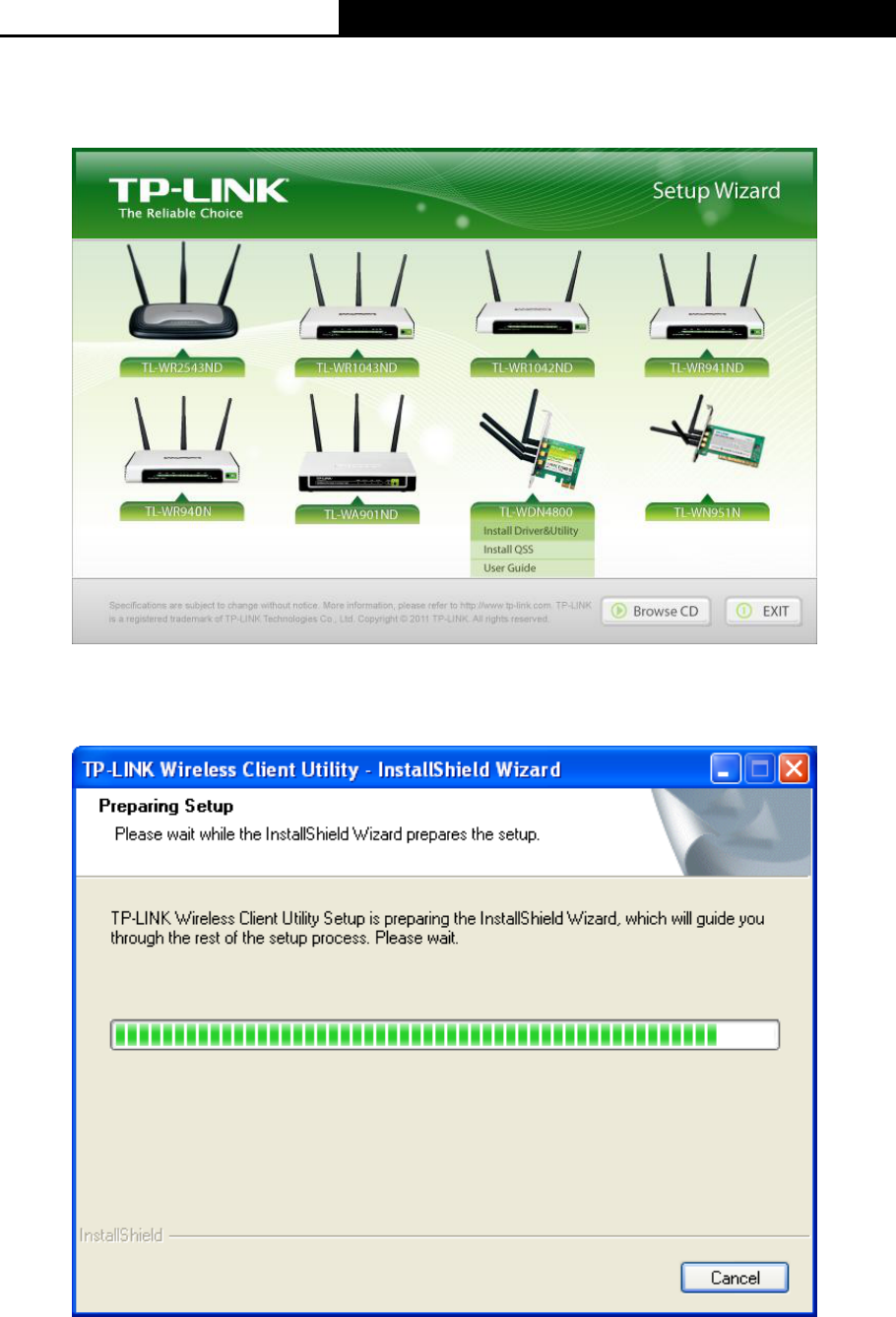
TL-WDN4800
450Mbps Wireless N Dual Band PCI Express Adapter
5
2. To continue, select the TL-WDN4800.There will be a menu including: Install Driver&Utility,
Install QSS and User Guide.
Figure 2-2
3. Click Install Driver&Utility in the above Figure 2-2 to load the following screen.
Figure 2-3
4. After a few moments Figure 2-4 will appear. Click Next to continue.
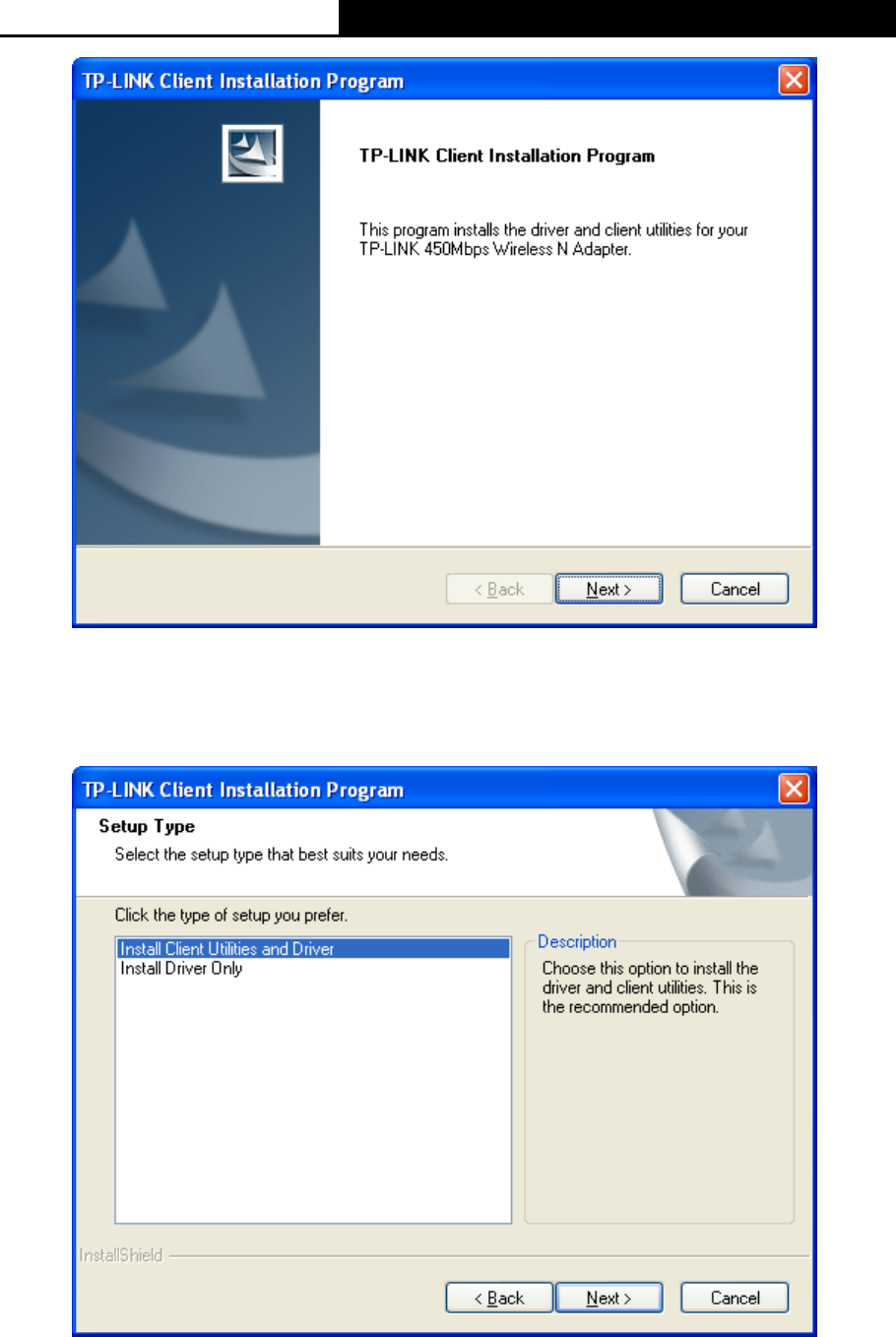
TL-WDN4800
450Mbps Wireless N Dual Band PCI Express Adapter
6
Figure 2-4
5. After that, you should choose a Setup type. It is recommended that you select Install Client
Utilities and Driver. Click Next to continue.
Figure 2-5
6. Click Browse... to change the destination location for the software. It’s recommended that
you leave it default; then click Next in the screen below (shown in Figure 2-6).
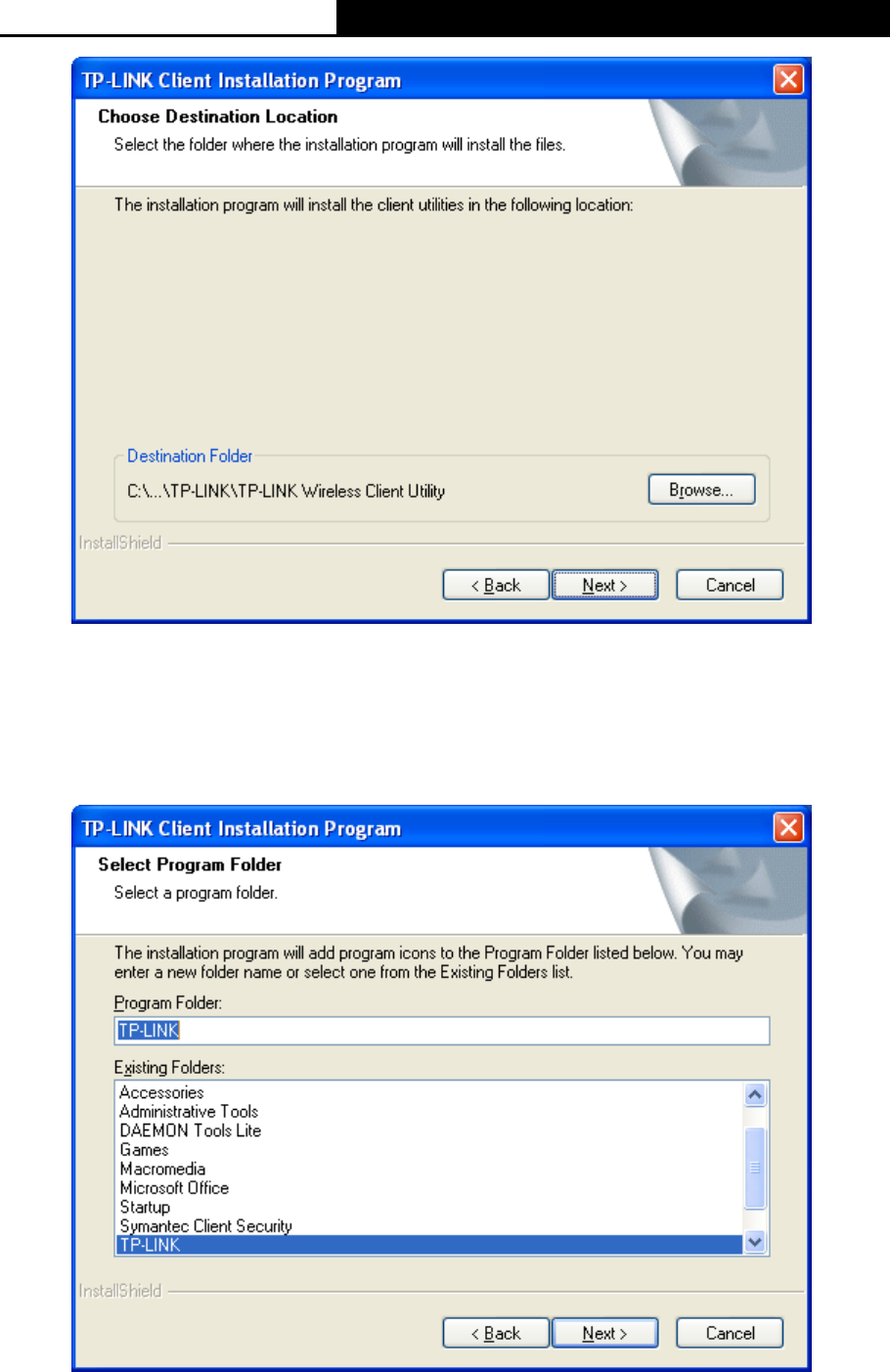
TL-WDN4800
450Mbps Wireless N Dual Band PCI Express Adapter
7
Figure 2-6
7. After that, select the program folder. You can create a new folder name or select one from the
Existing Folders list. It is recommended that you keep the default setting. Click Next to
continue the installation.
Figure 2-7
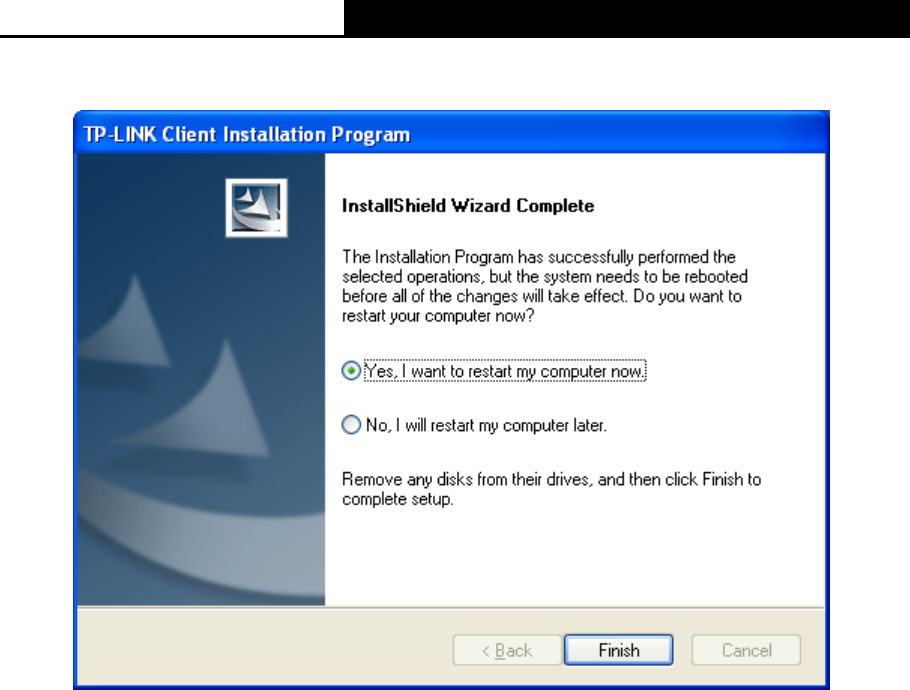
TL-WDN4800
450Mbps Wireless N Dual Band PCI Express Adapter
9
10. After all the steps above, you will see the screen below; click Finish to reboot your computer.
Figure 2-10

TL-WDN4800
450Mbps Wireless N Dual Band PCI Express Adapter
10
Chapter 3. Configuration Guide
3.1 For Windows XP
In Windows XP, TP-LINK TL-WDN4800 can be configured by TP-LINK Wireless Configuration
Utility (TWCU). This chapter describes how to configure your Adapter for wireless connectivity on
your Wireless Local Area Network (WLAN) and use the data security encryption features.
After Installing the Adapter, the Adapter’s tray icon will appear in your system tray. It appears
at the bottom of the screen, and shows the signal strength using color and the received signal
strength indication (RSSI).
If the icon is gray, there is no connection.
If the icon is red, there is poor signal strength and the RSSI is less than 5dB.
If the icon is yellow, there is poor signal strength and the RSSI is between 5dB and 10dB.
If the icon is green, there is good signal strength and the RSSI is between 10dB and 20dB.
If the icon is green, there is excellent signal strength and the RSSI is more than 20dB.
Double-click the icon and the TWCU will run. You can also run the utility by clicking the Start →
All Programs → TP-LINK → TP-LINK Wireless Configuration Utility. The TWCU provides
some integrated and easy tools to:
Display current status information
Edit and add configuration profiles
Display current diagnostics information
The section below introduces these above capabilities.
3.1.1 Current Status
The Current Status tab contains general information about the program and its operations. The
Current Status tab needn’t any configurations.
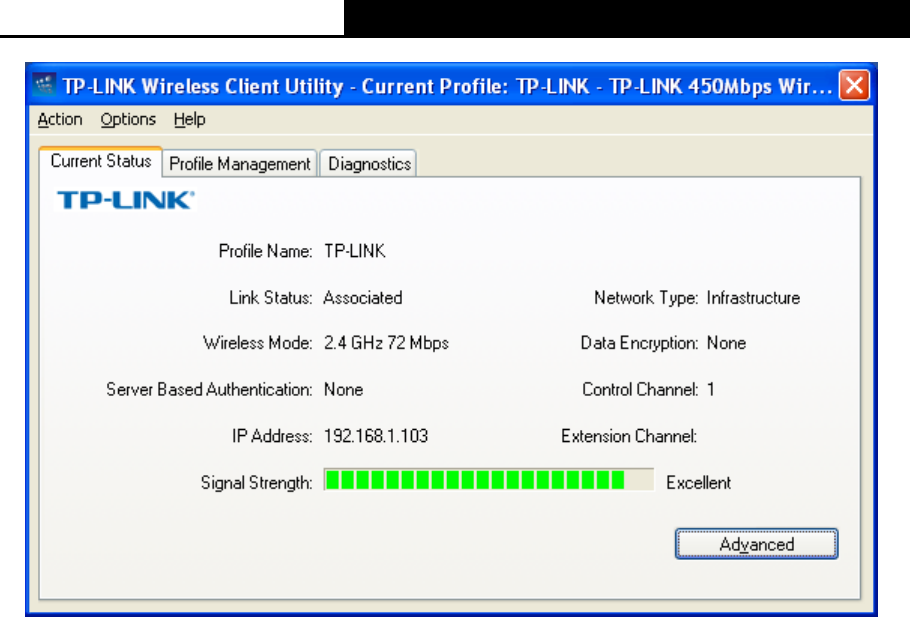
TL-WDN4800
450Mbps Wireless N Dual Band PCI Express Adapter
11
Figure 3-1
The following table describes the items found on the Current Status screen.
Profile Name - This shows the name of current selected configuration profile. The
configuration of Profile name will be described on the General tab of Profile Management.
Link Status - This shows whether the station is associated to the wireless network.
Wireless Mode - Here displays the wireless mode.
Network Type - The type of network and the station currently connected are shown here.
The options include:
Infrastructure (access point)
Ad Hoc
Note:
You can configure the network type and wireless mode on the Advanced tab of Profile
Management.
IP Address - This displays the computer’s IP address.
Control Channel - This shows the currently connected channel.
Data Encryption - Here displays the encryption type the driver is using. You can configure it
on the Security tab of Profile Management.
Server Based Authentication - This shows whether the server based authentication is
used.
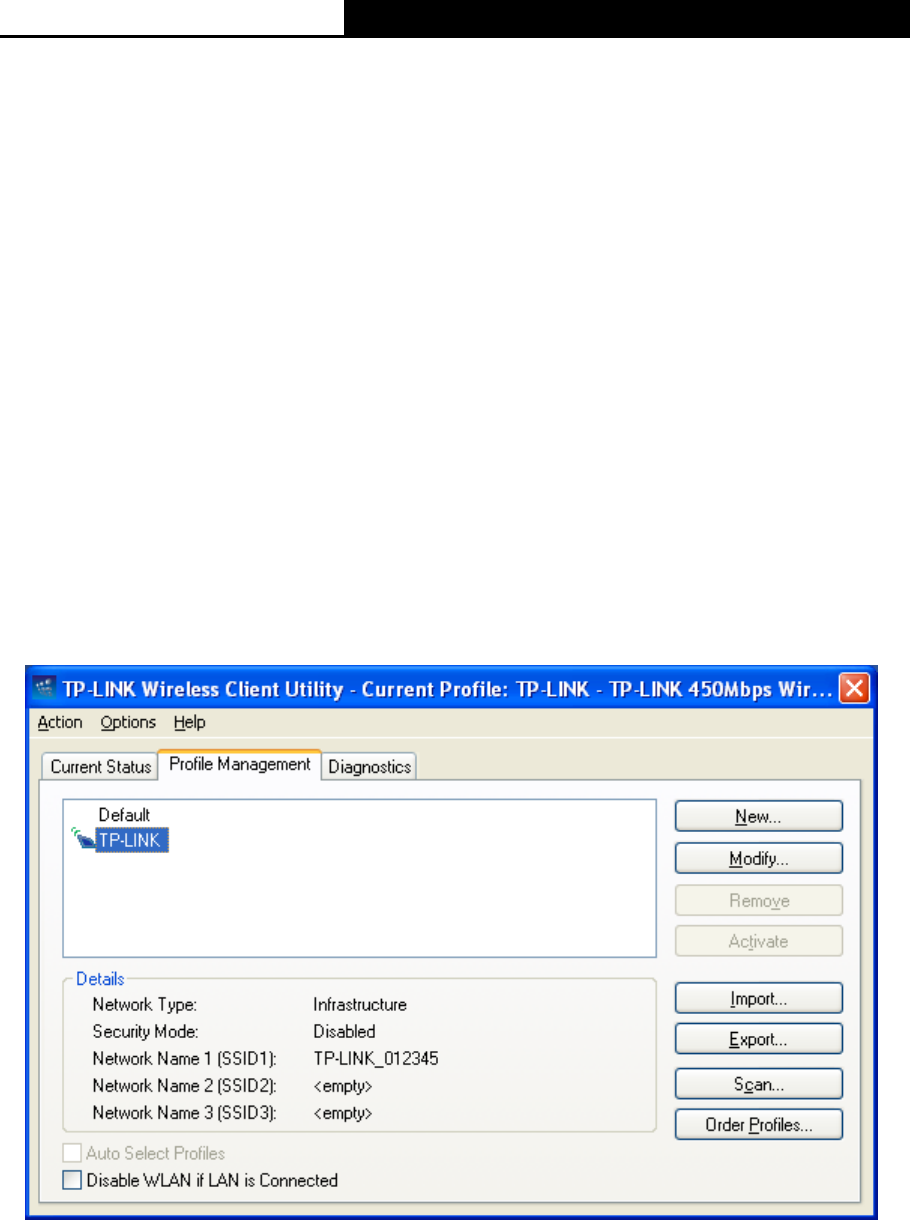
TL-WDN4800
450Mbps Wireless N Dual Band PCI Express Adapter
12
Signal Strength - This shows the strength of the signal.
Click Advanced on the screen above, you can see advanced information about the program and
its operations.
3.1.2 Profile Management
Click the Profile Management tab of the TWCU and the next screen will appear (shown in Figure
3-2X). The Profile Management screen provides tools to:
Add a new profile
Modify a profile
Remove a profile
Activate a Profile
Import a Profile
Export a Profile
Scan Available Networks
Order profiles
Figure 3-2
3.1.2.1. Add or Modify a Configuration Profile
To add a new configuration profile, click New on the Profile Management tab. To modify a
configuration profile, select the configuration profile from the Profile list and click Modify. Then
you will see the Management dialog box (shown in Figure 3-3).
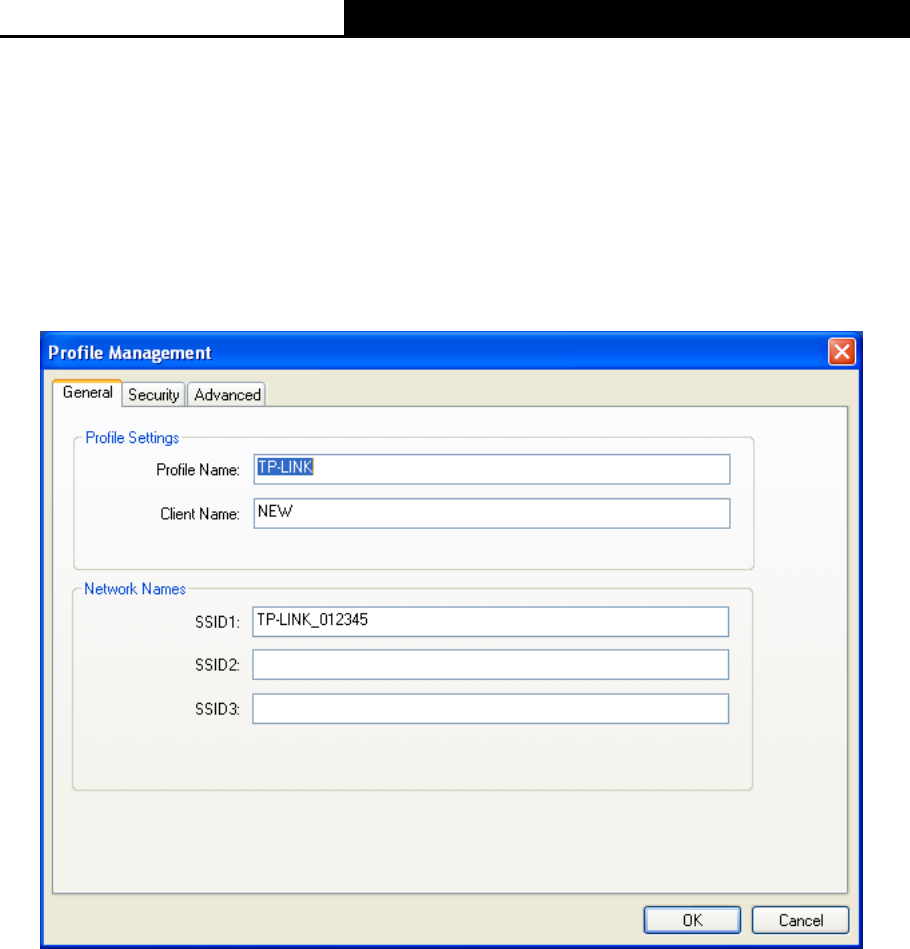
TL-WDN4800
450Mbps Wireless N Dual Band PCI Express Adapter
13
1. Edit the General tab
Profile Name - Please enter the Profile name which identifies the configuration profile. This
name must be unique. Note that the profile names are not case-sensitive.
Client Name - Please enter a name which identifies the client machine.
Network Names (SSIDs) - Please enter the IEEE 802.11 wireless network name. This field
has a maximum limit of 32 characters.
Figure 3-3
2. Edit the Security tab
Select the Security tab in the screen above, and then you can edit the fields to configure the
profile. To define the security mode, select the radio button of the desired security mode as
follows.
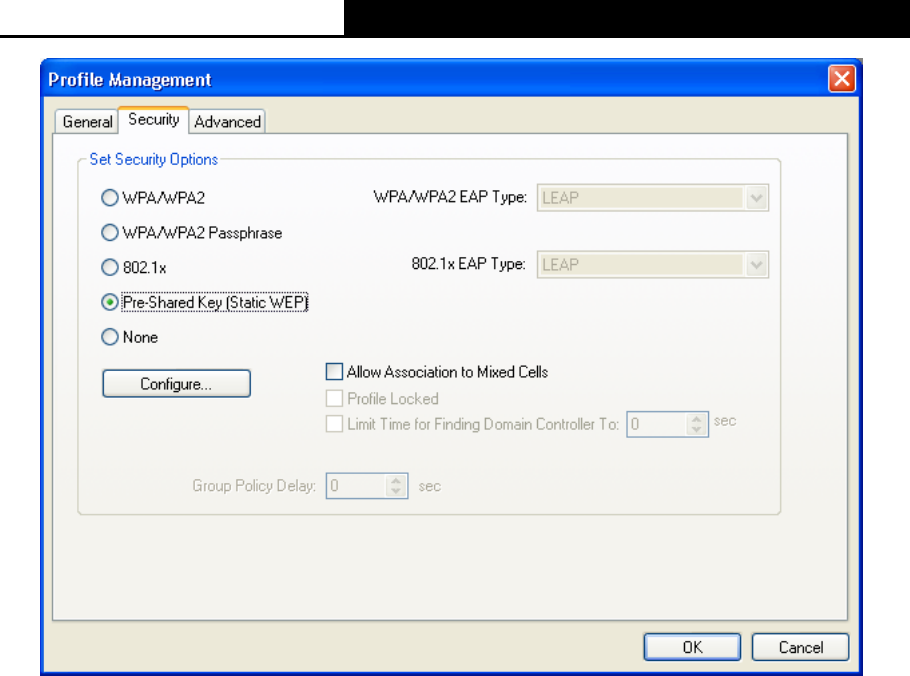
TL-WDN4800
450Mbps Wireless N Dual Band PCI Express Adapter
14
Figure 3-4
WPA/WPA2: Wi-Fi Protected Access
WPA/WPA2 Passphrase: Wi-Fi Protected Access Passphrase
802.1x: Enables 802.1x security.
Pre-Shared Key (Static WEP): Enables the use of shared keys that are defined on both the
access point and the station. To define shared encryption keys, choose the Shared Key radio
button and click Configure to fill in the Define Shared Keys window (shown in Figure 3-5X).
Note:
The WEP security mode is not available for 802.11n.
None: No security (not recommended).
Note:
If the access point which the Adapter is associated has WEP set and the client has WEP enabled,
make sure that Allow Association to Mixed Cells is checked on the Security tab to allow
association. To complete WEP encryption configuration, you must select the 802.11
Authentication Mode as appropriate on the Advanced tab of this Profile Management dialog.
To configure the Encryption Keys under the Pre-Shared keys (Static WEP) Security mode:
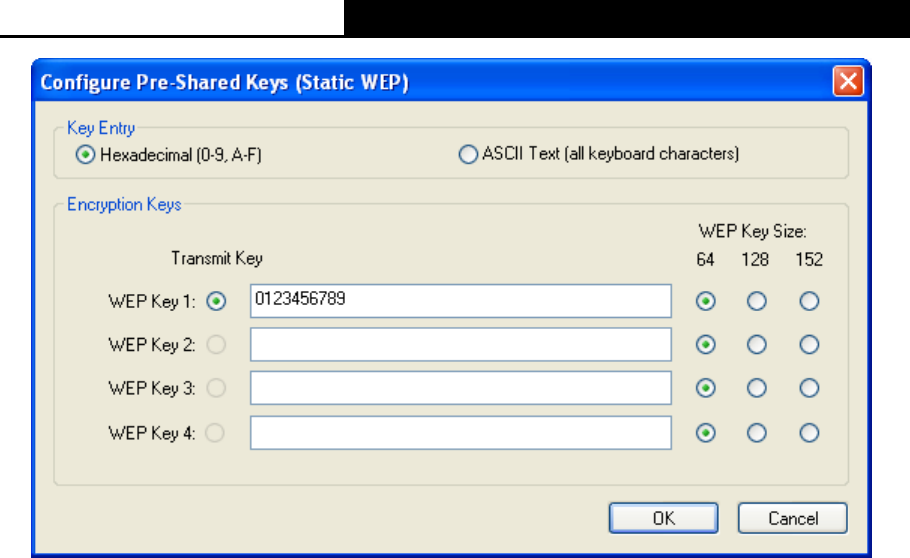
TL-WDN4800
450Mbps Wireless N Dual Band PCI Express Adapter
15
Figure 3-5
Note:
Select different Security Options, the configurations are different; you can select the appropriate
security option and configure the exact key as your need.
3. Edit the Advanced tab
This screen below allows you to make advanced configuration for the profile.
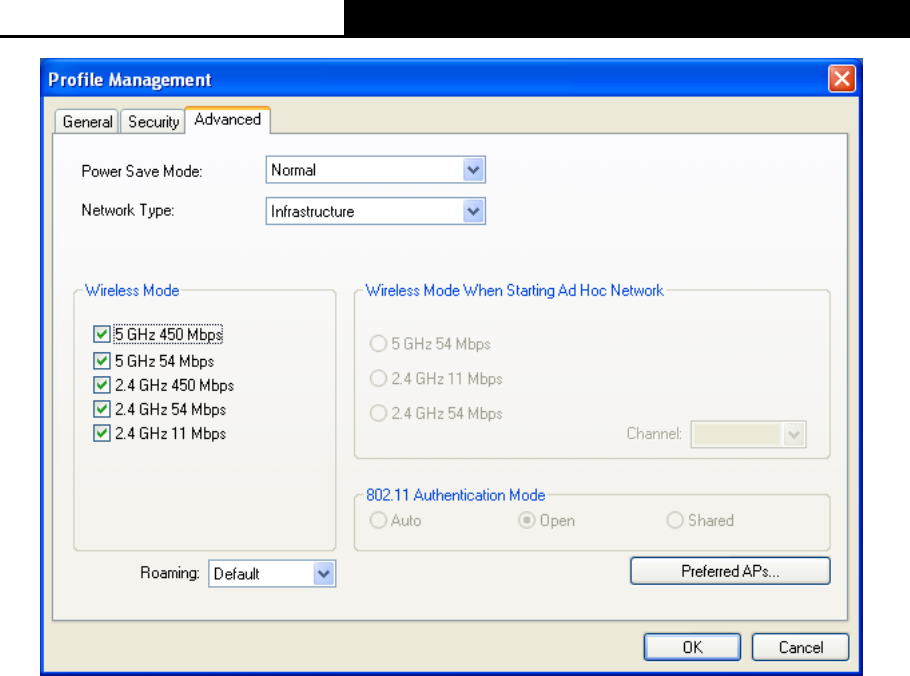
TL-WDN4800
450Mbps Wireless N Dual Band PCI Express Adapter
16
Figure 3-6
Power Save Mode - Please select the power save mode in the drop-down list.
Maximum - Selects maximum mode to let the access point buffer incoming messages
for the Adapter. The Adapter will detect the access point if any messages are waiting
periodically.
Normal - Normal mode uses maximum when retrieving a large number of packets, then
switches back to power save mode after retrieving the packets.
Off - Turns power saving off, thus powering up the Wireless PCI Express Adapter
continuously for a short message response time.
Network Type: There are basically two modes of networking:
Infrastructure - All wireless clients will connect to an access point or wireless Router.
Ad-Hoc - Directly connecting to another computer, for peer-to-peer communication,
using wireless network adapters on each computer, such as two or more TL-WDN4800
wireless adapters.
Note:
1) An Infrastructure network contains an Access Point or wireless Router. All the wireless
devices or clients will connect to the wireless Router or access point.
2) An Ad-Hoc network contains only clients, such as laptops with wireless desktop adapters. All
the adapters must be in Ad-Hoc mode to communicate.

TL-WDN4800
450Mbps Wireless N Dual Band PCI Express Adapter
17
Wireless Mode: Specifies 2.4 GHz 450 Mbps, 2.4 GHz 54 Mbps or 2.4 GHz 11 Mbps
operation in an access point network. The Wireless adapter must match the wireless mode of
the access point with which it associates.
Wireless Mode when Starting an HAd HocH Network: Specifies 2.4 GHz 54/11 Mbps to start
an Ad Hoc network if no matching network name is found after scanning all available modes.
This mode also allows the selection of the channel that the Wireless Adapter uses. The
channels available depend on the regulatory domain. If the adapter finds no other ad hoc
adapters, the channel that the adapter starts the ad hoc network with will be selected
automatically. The Adapter must match the wireless mode and channel of the clients it
associates.
802.11 Authentication Mode: Select which mode the Adapter uses to authenticate to an
access point:
Auto - Automatic causes the adapter to attempt authentication using shared, but
switches it to open authentication if shared fails.
Open - Open System enables an adapter to attempt authentication regardless of its
WEP settings. It will only associate with the access point if the WEP keys on both the
adapter and the access point match.
Shared - Shared-key only allows the adapter to associate with access points that have
the same WEP key.
For infrastructure (access point) networks, click Preferred APs… to specify four access points at
most to the client adapter that attempts to be associated to the access points. The four access
points have different priorities; the frontal has the higher priority.
Figure 3-7
3.1.2.2. Remove a profile
1. Go to the Profile Management tab (shown in Figure 3-2X).
2. Select the profile name in the Profiles List.
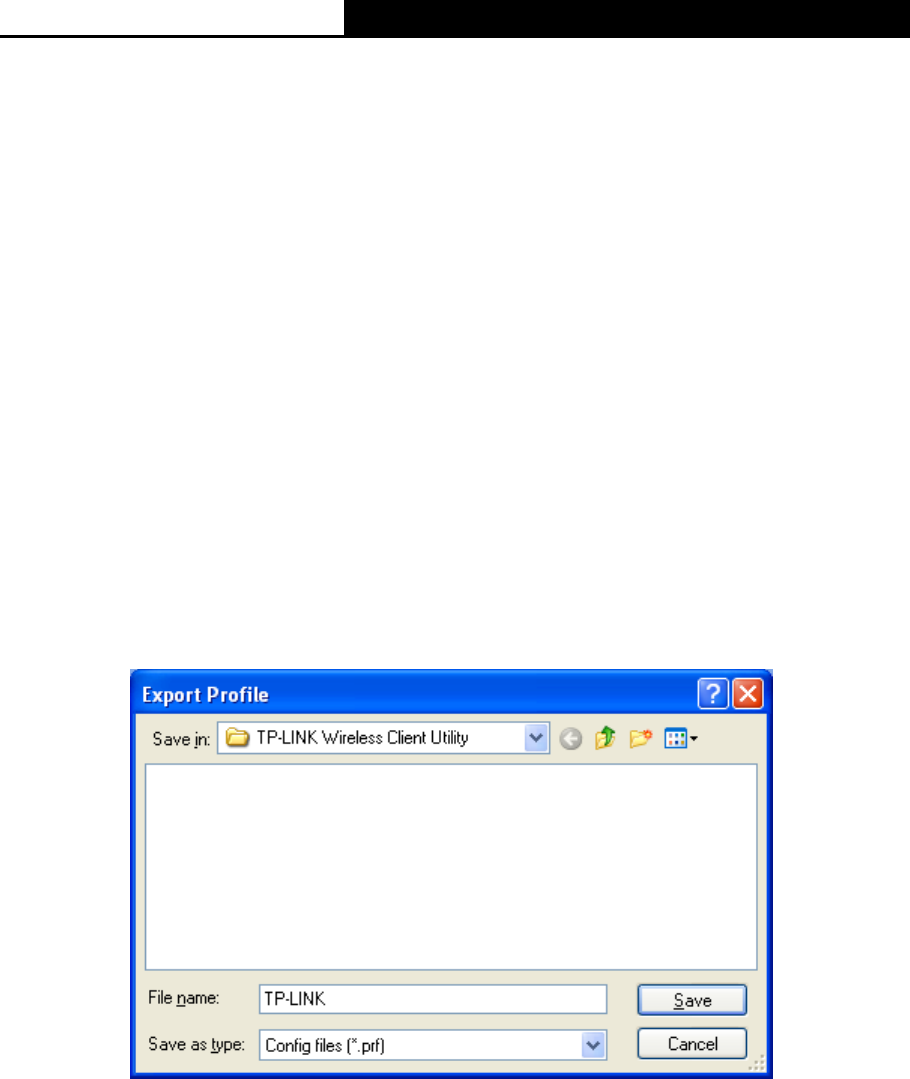
TL-WDN4800
450Mbps Wireless N Dual Band PCI Express Adapter
18
3. Click Remove.
Note:
The profile being used can’t be removed.
3.1.2.3. Switch another Profile
1. Go to the Profile Management screen (shown in Figure 3-2X).
2. Select the profile name required in the Profiles List.
3. Click Activate.
3.1.2.4. Export a Profile
1. From the Profile Management screen (shown in Figure 3-2X), highlight the profile to export.
2. Click Export…, the Export Profile window will then appear below.
3. Browse the directory to export the profile to.
4. Click Save. The profile should then be exported to the specified location.
Figure 3-8
3.1.2.5. Import a Profile
1. From the Profile Management screen (shown in Figure 3-2), click Import…. Then the Import
Profile will appear below.
2. Browse to the directory where the profile is located.
3. Highlight the profile name.
4. Click Open, the imported profile will then appear in the Profiles List.
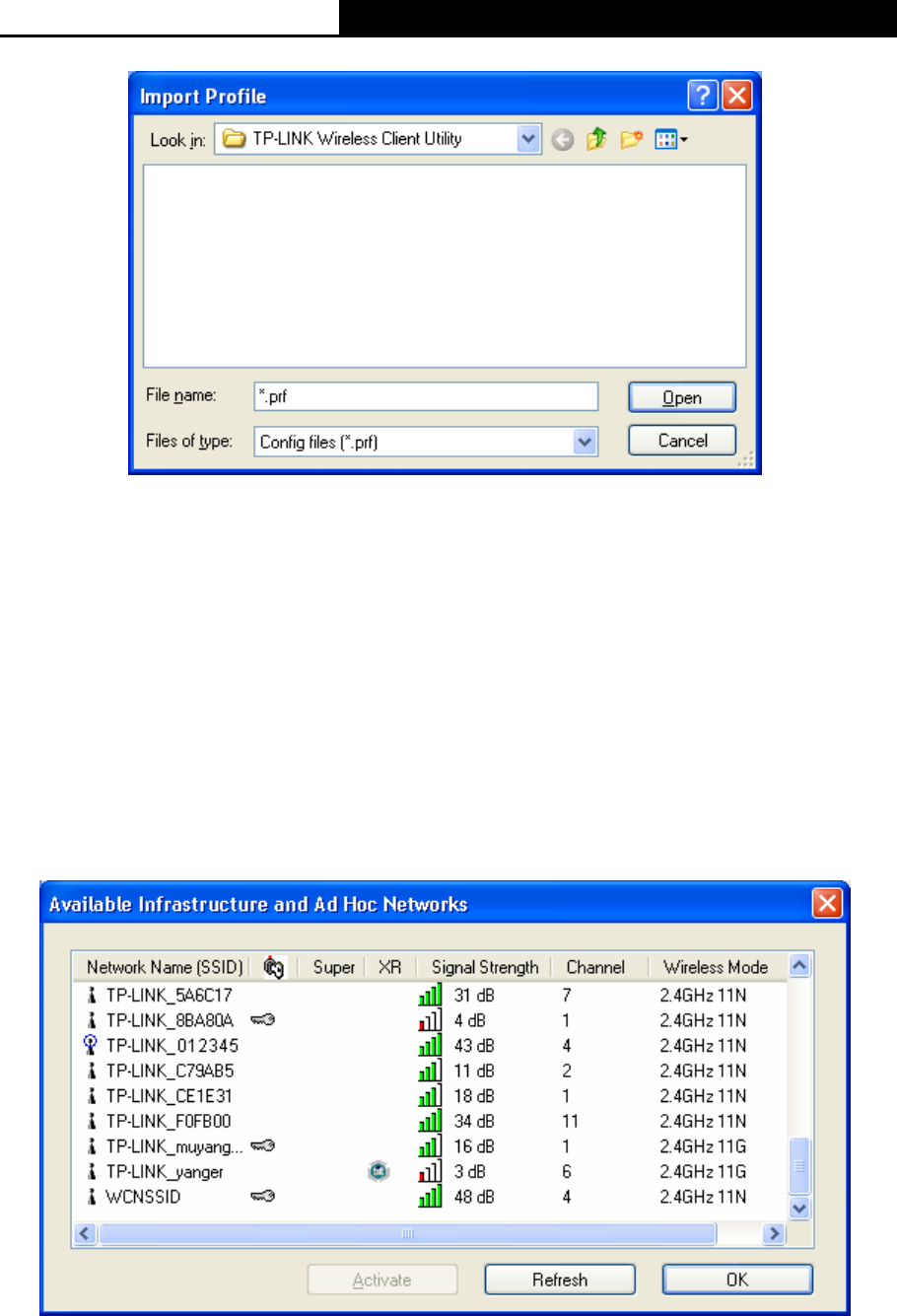
TL-WDN4800
450Mbps Wireless N Dual Band PCI Express Adapter
19
Figure 3-9
3.1.2.6. Scan Available Networks
1. Click Scan on the Profile Management screen (shown in Figure 3-2X), the Available
Infrastructure and Ad Hoc Networks window will appear below.
2. Click Refresh to refresh the list at any time.
3. Highlight a network name and click Activate to connect to an available network. If no
configuration profile exists for that network, the Profile Management window will open the
General tab screen. Fill in the Profile name and click OK to create the configuration profile for
that network.
Figure 3-10
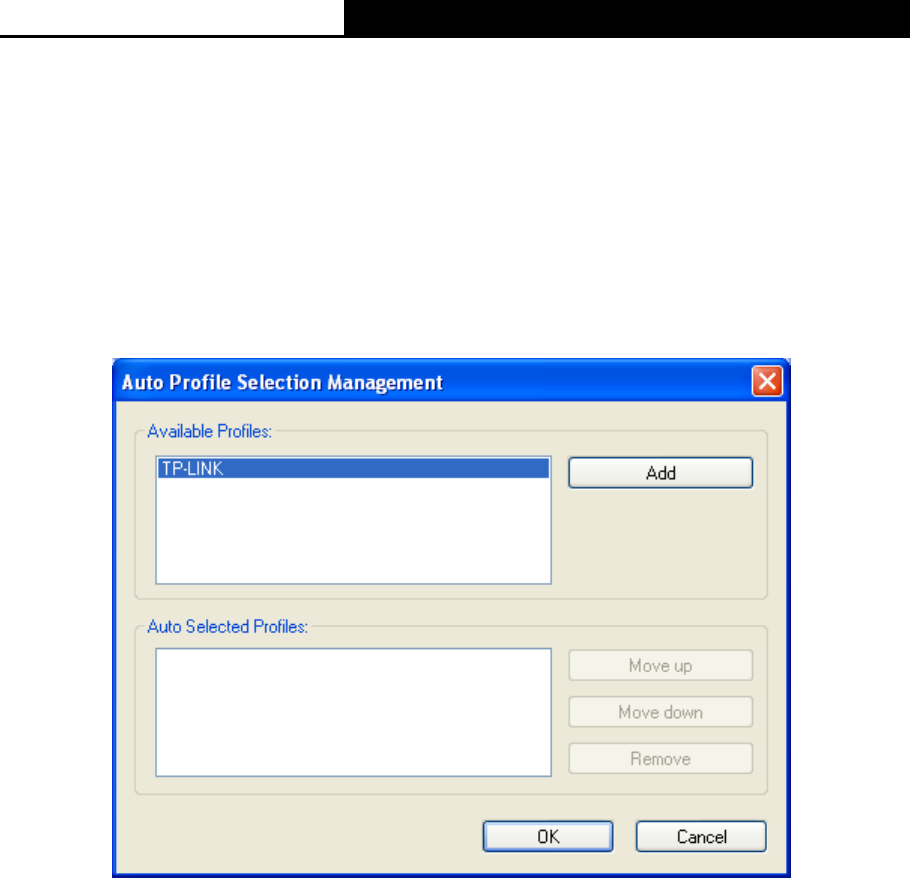
TL-WDN4800
450Mbps Wireless N Dual Band PCI Express Adapter
20
3.1.2.7. Auto Profile Selection Management
The auto selection feature allows the adapter to automatically select a profile from the list of
profiles and use it to connect to the network. To add a new profile into the Auto Selected Profiles
list, please follow these steps.
1. On the Profile Management screen (shown in Figure 3-2X), click Order Profiles….
2. The Auto Profiles Selection management window will appear (shown in Figure 3-11) with a
list of all created profiles in the Available Profiles.
Figure 3-11
3. Highlight the profiles to add to auto profile selection, and click Add. The profile will appear in
the Auto Selected Profiles box.
4. Highlight a profile in the Auto Selected Profiles box.
5. Click Move Up or Move Down as appropriate.
Note:
The first profile in the Auto Selected Profiles box has highest priority, while the last profile has the
lowest priority.
6. Click OK.
7. Check the Auto Select Profiles checkbox on the Profile Management tab (shown in Figure 3-2).
Note:
When auto profile selection is enabled by checking Auto Select Profiles on the Profile
Management tab, the client adapter will scan for an available network. The profile with the
highest priority and the same SSID as one of the found networks will be used to connect to the
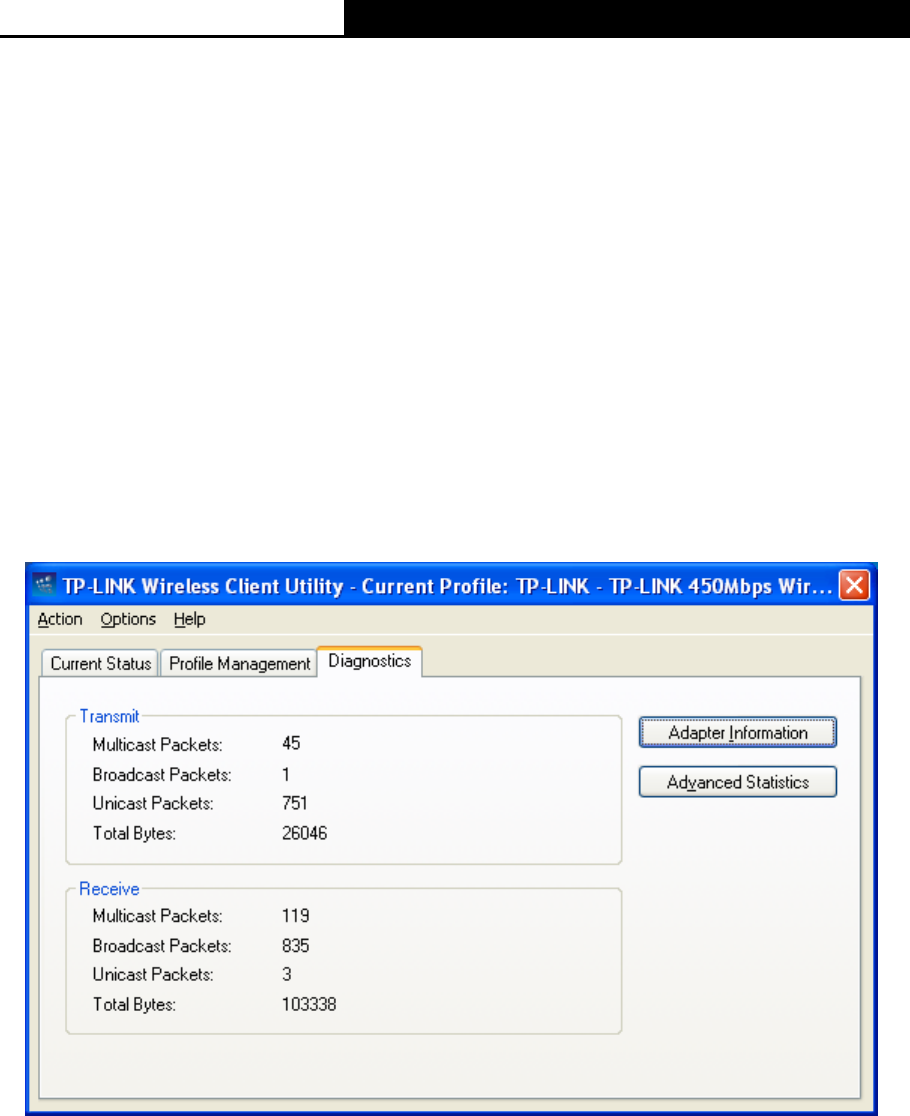
TL-WDN4800
450Mbps Wireless N Dual Band PCI Express Adapter
21
network. If the connection fails, the client adapter will try the next highest priority profile that
matches the SSID until an available network is found.
3.1.3 Diagnostics
The Diagnostics tab of the TP-LINK Wireless Configuration Utility (TWCU) provides buttons used
to retrieve receiving and transmitting statistics. The Diagnostics tab does not require any
configuration.
The Diagnostics tab lists the following receiving and transmitting diagnostics for frames received
or transmitted by the wireless network adapter:
Multicast frames transmitted and received
Broadcast frames transmitted and received
Unicast frames transmitted and received
Total bytes transmitted and received
Figure 3-12
3.1.3.1. Check Driver Information
Click the Adapter Information button in the screen above, you will see the adapter information,
including general information about the wireless network adapter and the Network Driver Interface
Specification (NDIS) driver. Access the adapter information from the Diagnostics tab.
Card Name - The name of the wireless network adapter.
MAC Address - The MAC address of the wireless network adapter.
Driver - The driver name and path of the wireless network adapter driver.
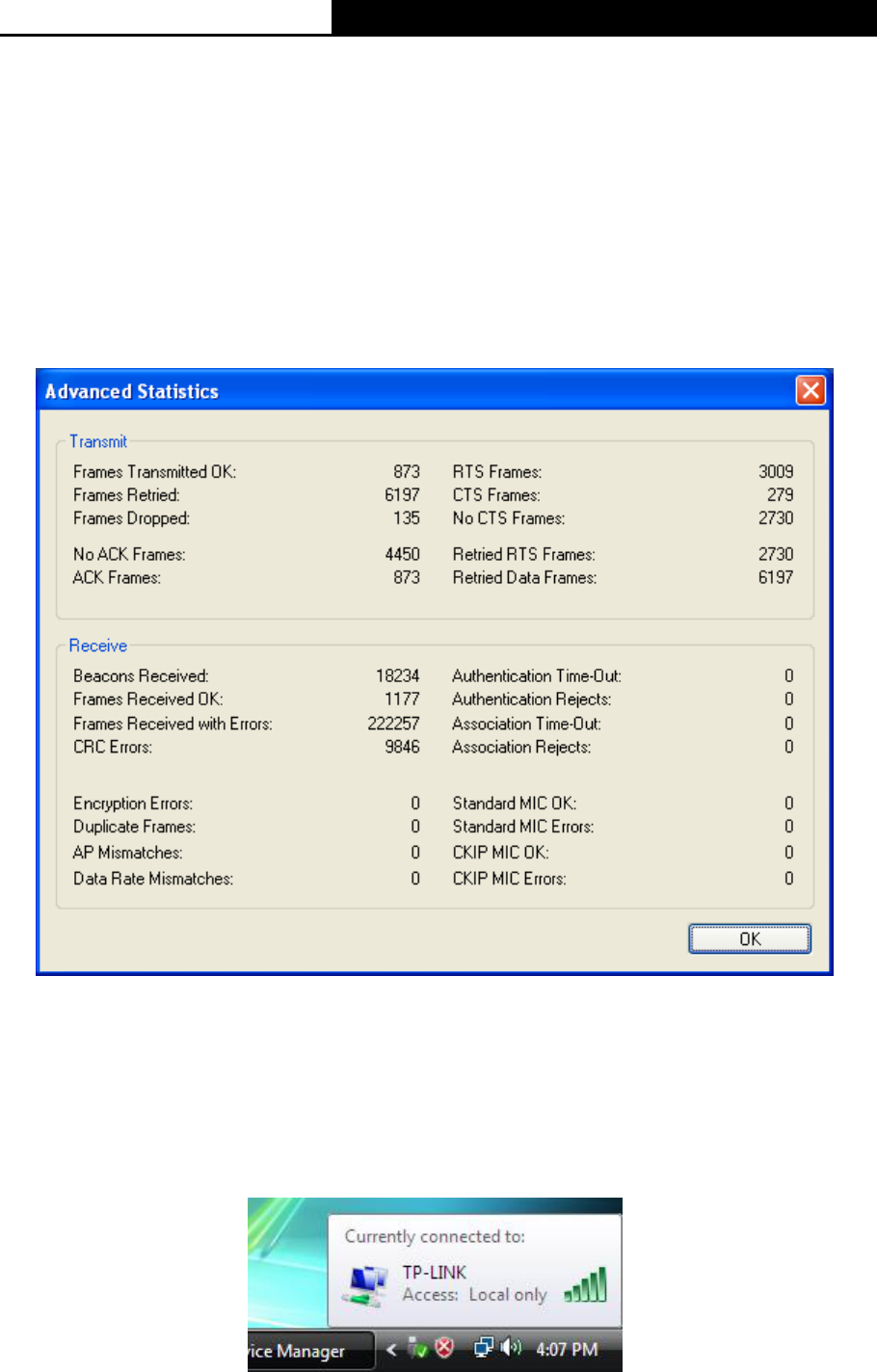
TL-WDN4800
450Mbps Wireless N Dual Band PCI Express Adapter
22
Driver Version - The version of the wireless network adapter driver.
Driver Date - The creation date of the wireless network adapter driver.
Client Name - The name of the client computer.
3.1.3.2. Check Receive and Transmit Statistical Information
The Advanced Statistics show receiving and transmitting statistical information about the
following receiving and transmitting diagnostics for frames received by or transmitted to the
wireless network adapter.
Figure 3-13
3.2 For Windows Vista
After the Adapter's driver has been installed, Windows Vista will display a wireless Network
Connection message like this one.
Figure 3-14
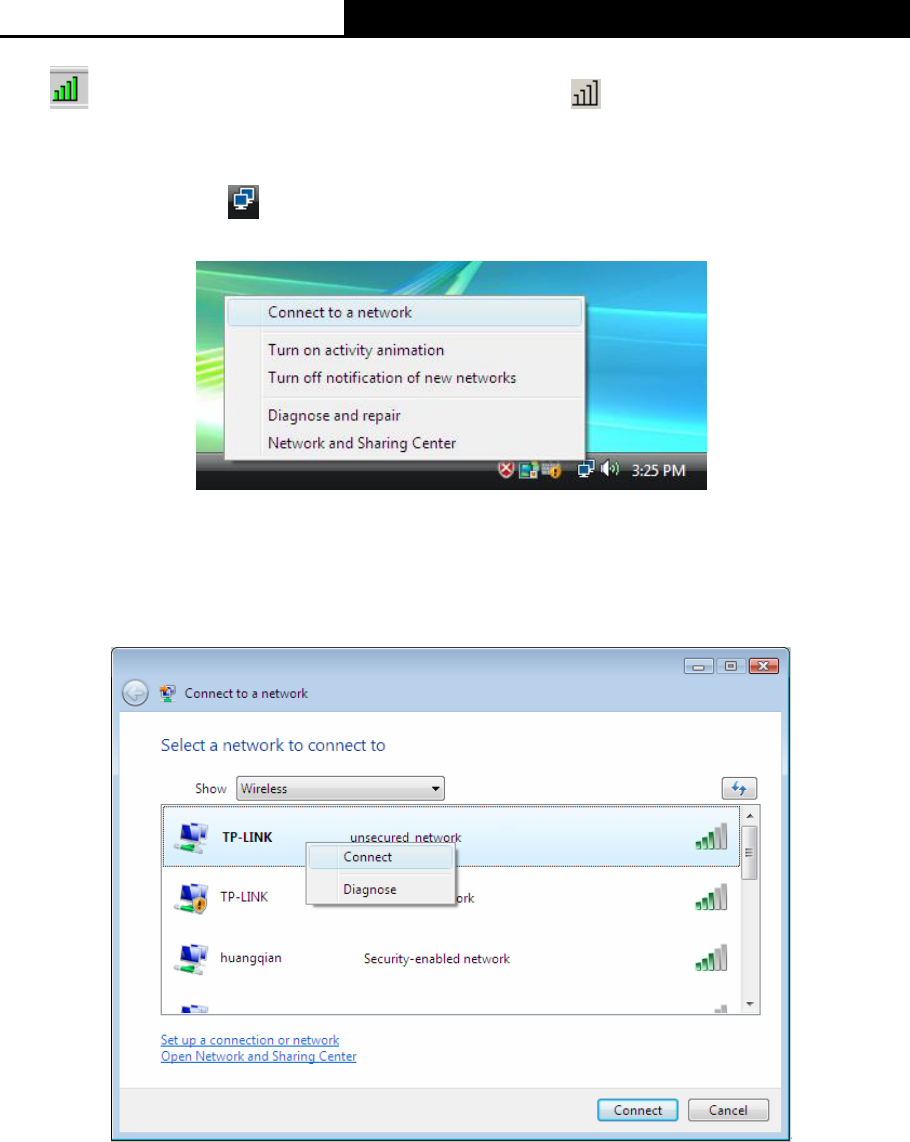
TL-WDN4800
450Mbps Wireless N Dual Band PCI Express Adapter
23
Icon means the connection has been established. Icon means there is no connection.
To establish a connection, please follow the steps below.
1. Right-click the icon in your system tray, then click Connect to a network.
Figure 3-15
2. The following screen will show you available wireless networks. Highlight the one you want to
join, and then click Connect.
Figure 3-16
3. To continue, click Connect Anyway. (Click the Cancel button to end the connection.)
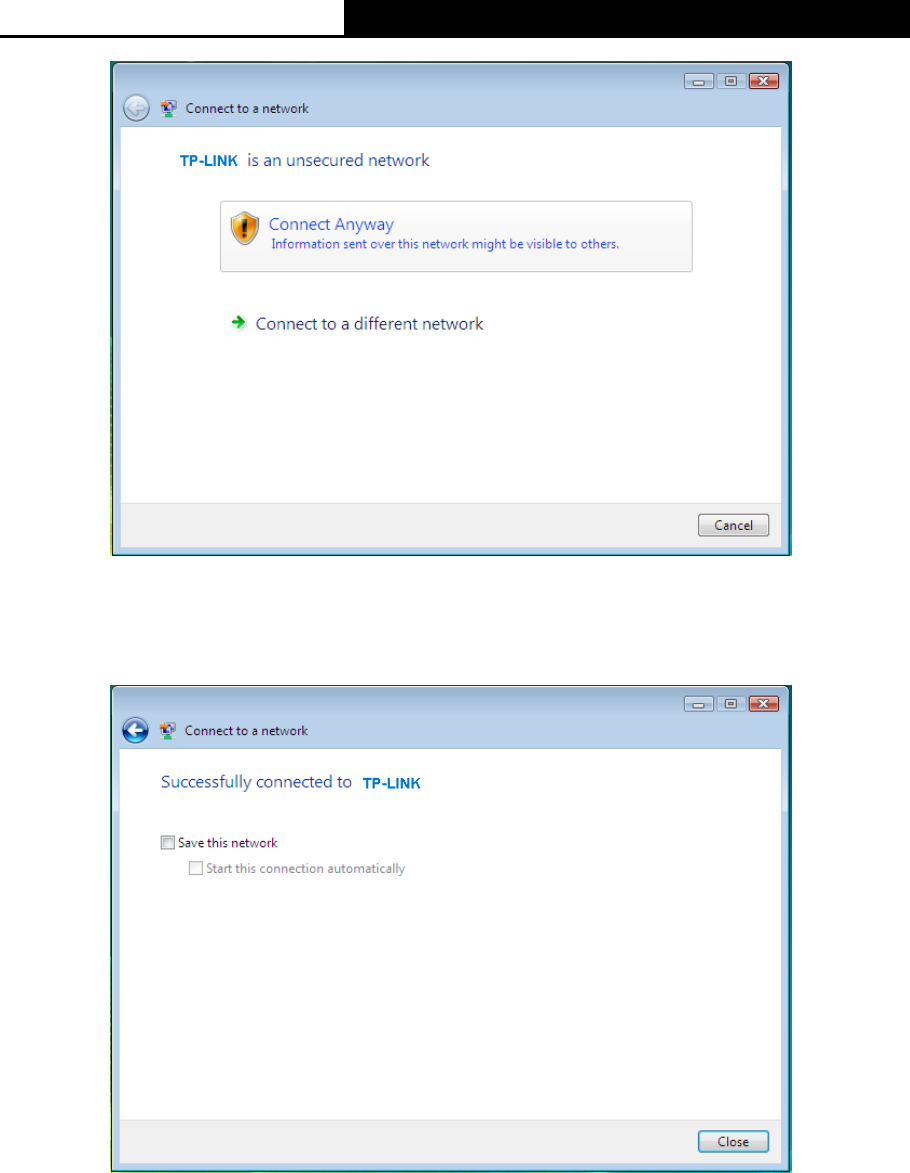
TL-WDN4800
450Mbps Wireless N Dual Band PCI Express Adapter
24
Figure 3-17
4. If the connection is successfully established, the following screen will appear; click Close to
complete the connection.
Figure 3-18
3.3 For Windows 7
TP-LINK Wireless Configuration Utility (TWCU) is not available for Windows 7. So after the
Adapter's driver has been installed, we have to use Windows WLAN Autoconfig to establish a
connection. Please follow the steps below.
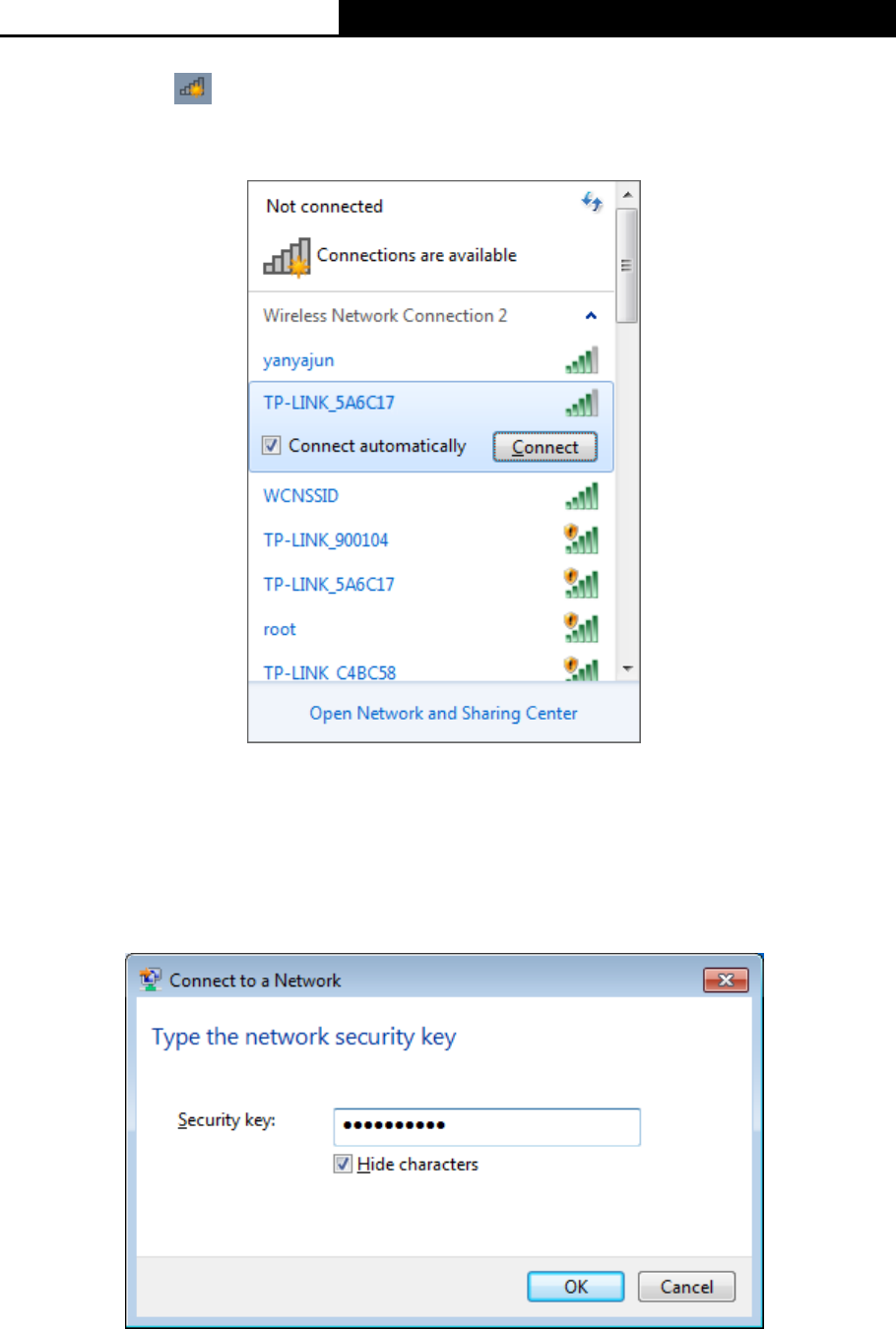
TL-WDN4800
450Mbps Wireless N Dual Band PCI Express Adapter
25
1. Click the icon at the bottom of your screen in your system tray and then you will see the
available wireless network list. Select the SSID of your Access Point and click Connect.
Figure 3-19
2. If your wireless network is secured, you will be required to enter the security key as shown in
Figure 3-20. Enter the password in the Security Key field, take 1234567890 for example.
And then click OK.
Figure 3-20
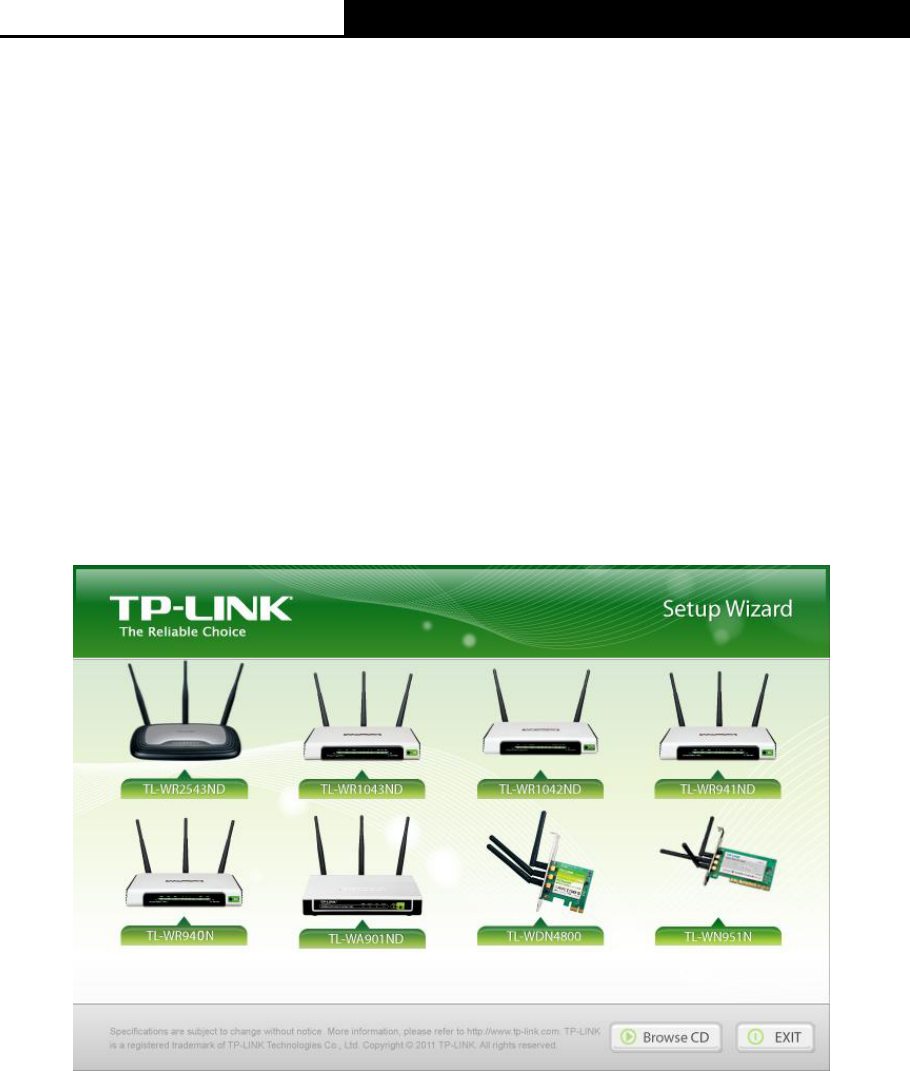
TL-WDN4800
450Mbps Wireless N Dual Band PCI Express Adapter
27
Chapter 4. QSS Configuration
QSS (Quick Secure Setup) function allows you to add a new wireless device to an existing
network quickly.
If the wireless Router supports Wi-Fi Protected Setup (WPS), you can establish a wireless
connection between wireless card and Router using either Push Button Configuration (PBC)
method or PIN method.
Note:
QSS function is not supported in Windows 7 OS.
First of all, the QSS software should be installed. Below are the steps for the installation.
1. Insert the Resource CD into your CD-ROM drive, and the Figure 4-1 will appear.
Figure 4-1
2. To continue, select the TL-WDN4800.There will be a menu including: Install Driver&Utility,
Install QSS and User Guide.
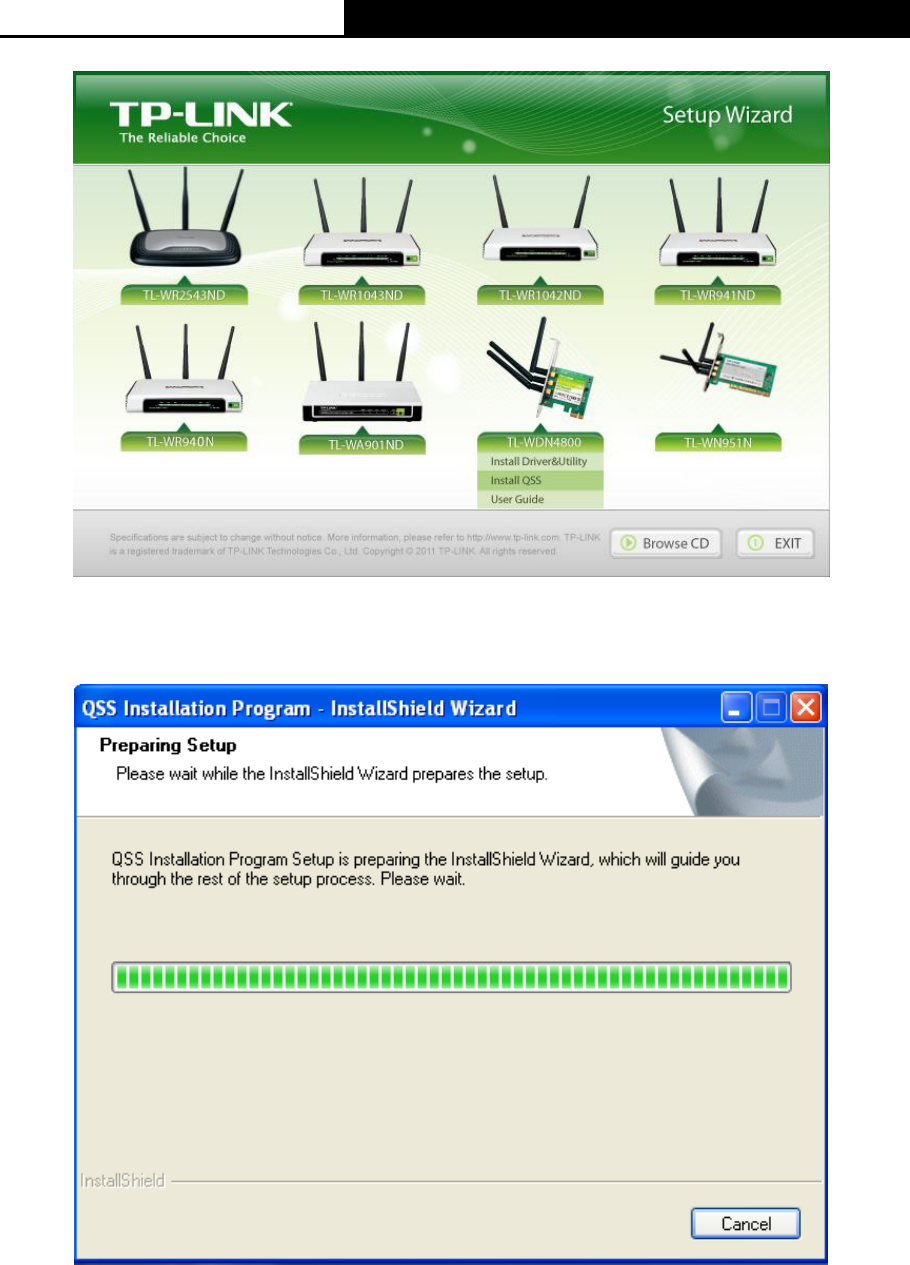
TL-WDN4800
450Mbps Wireless N Dual Band PCI Express Adapter
28
Figure 4-2
3. Select Install QSS in the above Figure 4-2 to load the following screen.
Figure 4-3
Then, please follow the instructions of the Operation System to complete the QSS installation.
After that, QSS function can be enabled. Here we will introduce two ways to configure the QSS
(For the configuration of QSS, here takes the Wireless Router of our company for example).
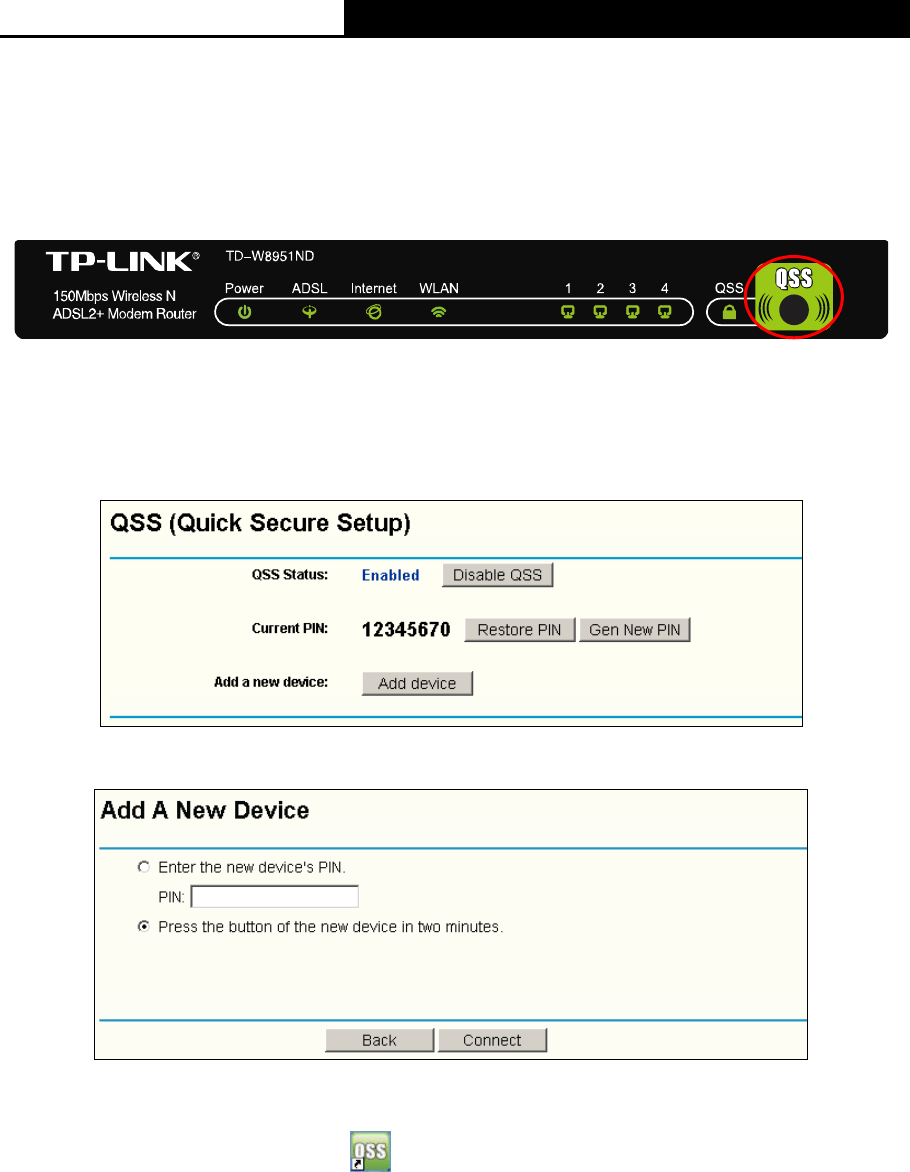
TL-WDN4800
450Mbps Wireless N Dual Band PCI Express Adapter
29
4.1 PBC (Push Button Configuration) method
1. Firstly, press the QSS button of the Router. There are two ways:
1) Press the QSS button directly on the front panel of the Router shown in Figure 4-4.
Figure 4-4
2) Open the Router’s Web-based Utility and click QSS link on the left of the main menu.
Then Figure 4-5 will appear. Click Add device, then you can see Figure 4-6. Select
Press the button of the new device in two minutes and click Connect.
Figure 4-5
Figure 4-6
2. Secondly, Double click the icon on the desktop to open the QSS Utility and then you
can see the welcome screen shown as Figure 4-7. Click Next to continue. Then select Push
the button on my access point in the next screen shown in Figure 4-8 and click Next.
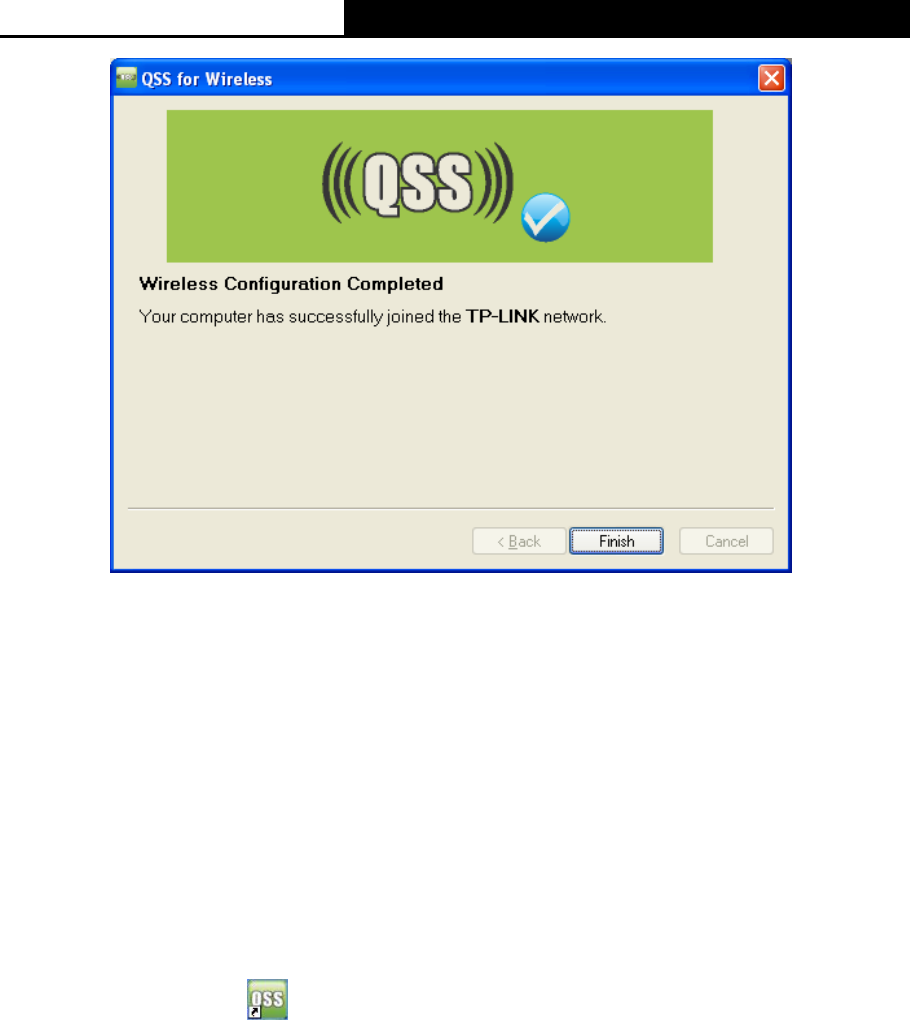
TL-WDN4800
450Mbps Wireless N Dual Band PCI Express Adapter
31
Figure 4-9
4.2 PIN method
There are two ways to configure the QSS by PIN method:
1) Enter a PIN into your AP device.
2) Enter the PIN from your AP device.
Following are the detailed configuration procedures of each way.
4.2.1 Enter a PIN into your AP device
1. Double-click the icon on the desktop to open the QSS Utility and then you can see the
welcome screen shown as Figure 4-7 Click Next to continue. Figure 4-10 will appear. Select
the second option and you will see the PIN value of the adapter which is randomly generated.
Click Next.
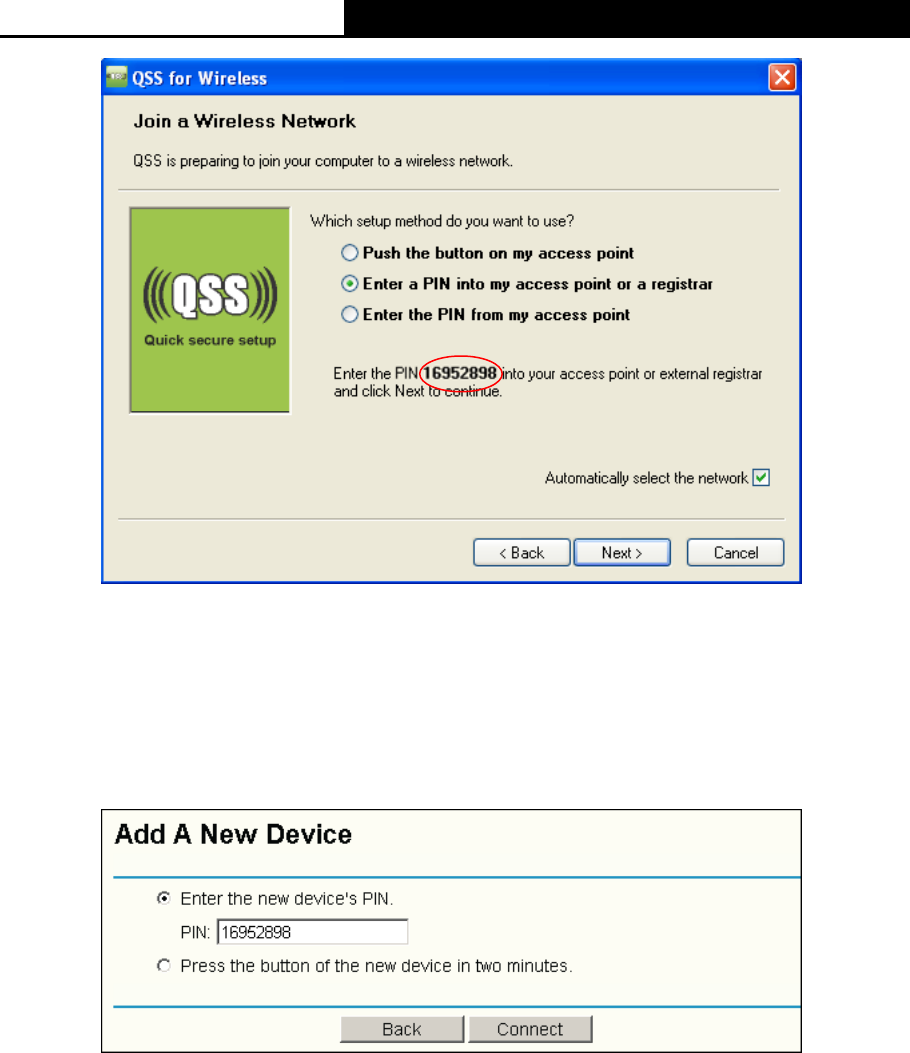
TL-WDN4800
450Mbps Wireless N Dual Band PCI Express Adapter
32
Figure 4-10
2. Open the Router’s Web-based Utility and click QSS link on the left of the main menu. Then
Figure 4-5 will appear. Click Add device, then you can see XFigure 4-11. Select Enter the
new device’s PIN and enter the PIN value of the adapter shown in Figure 4-11, click
Connect.
Figure 4-11
3. When Figure 4-9 appears, the QSS configuration is complete.
4.2.2 Enter the PIN from your AP device
1. Open the QSS Utility and you will see Figure 4-7 . Click Next to continue. Then Figure 4-12
will appear. Select the third option and enter the PIN value which is labeled on the bottom of
the Router. Click Next.

TL-WDN4800
450Mbps Wireless N Dual Band PCI Express Adapter
34
Appendix A: Specifications
Normal
Interface
PCI Express Interface
Standards
IEEE802.11a; IEEE802.11b; IEEE802.11g;
IEEE802.11n; IEEE802.1x
Operating System
Windows XP / Windows Vista / Windows 7
Radio Data Rate
11a: 6/9/12/18/24/36/48/54Mbps
11b: 1/2/5.5/11Mbps
11g: 6/9/12/18/24/36/48/54Mbps
11n: Up to 450Mbps
Modulation
11a: OFDM
11b: CCK, QPSK, BPSK;
11g: OFDM;
11n: QPSK, BPSK, 16-QAM, 64-QAM
Media Access Protocol
CSMA/CA with ACK
Data Security
64/128/152-bit WEP; WPA/WPA2; WPA-PSK/WPA2-PSK;
TKIP/AES
Frequency
2.4 ~ 2.4835GHz, 5.180 ~ 5.240GHz, 5.745 ~ 5.825GHz
Spread Spectrum
Direct Sequence Spread Spectrum (DSSS)
Safety & Emissions
FCC, CE, IC, RoHS, Wi-Fi
Environmental and Physical
Operating Temp.
0℃ ~ 40℃ (32℉~104℉)
Storage Temp.
-40℃ ~ 70℃ (-40℉~158℉)
Working Humidity
10% ~ 90% RH, Non-condensing
Storage Humidity
5% ~ 90% RH, Non-condensing

TL-WDN4800
450Mbps Wireless N Dual Band PCI Express Adapter
35
Appendix B: Glossary
802.11a - specification for wireless networking at 54 Mbps using OFDM modulation and
operating in radio band at 5GHz.
802.11b - The 802.11b standard specifies a wireless product networking at 11 Mbps using
direct-sequence spread-spectrum (DSSS) technology and operating in the unlicensed radio
spectrum at 2.4GHz, and WEP encryption for security. 802.11b networks are also referred to
as Wi-Fi networks.
802.11g - specification for wireless networking at 54 Mbps using direct-sequence
spread-spectrum (DSSS) technology, using OFDM modulation and operating in the
unlicensed radio spectrum at 2.4GHz, and backward compatibility with IEEE 802.11b devices,
and WEP encryption for security.
802.11n - 802.11n builds upon previous 802.11 standards by adding MIMO (multiple-input
multiple-output). MIMO uses multiple transmitter and receiver antennas to allow for increased
data throughput via spatial multiplexing and increased range by exploiting the spatial diversity,
perhaps through coding schemes like Alamouti coding. The Enhanced Wireless Consortium
(EWC) [3] was formed to help accelerate the IEEE 802.11n development process and
promote a technology specification for interoperability of next-generation wireless local area
networking (WLAN) products.
Ad-hoc Network - An ad-hoc network is a group of computers, each with a Wireless Adapter,
connected as an independent 802.11 wireless LAN. Ad-hoc wireless computers operate on a
peer-to-peer basis, communicating directly with each other without the use of an access point.
Ad-hoc mode is also referred to as an Independent Basic Service Set (IBSS) or as
peer-to-peer mode, and is useful at a departmental scale or SOHO operation.
DSSS - (Direct-Sequence Spread Spectrum) - DSSS generates a redundant bit pattern for all
data transmitted. This bit pattern is called a chip (or chipping code). Even if one or more bits
in the chip are damaged during transmission, statistical techniques embedded in the receiver
can recover the original data without the need of retransmission. To an unintended receiver,
DSSS appears as low power wideband noise and is rejected (ignored) by most narrowband
receivers. However, to an intended receiver (i.e. another wireless LAN endpoint), the DSSS
signal is recognized as the only valid signal, and interference is inherently rejected (ignored).
FHSS - (Frequency Hopping Spread Spectrum) - FHSS continuously changes (hops) the
carrier frequency of a conventional carrier several times per second according to a
pseudo-random set of channels. Because a fixed frequency is not used, and only the
transmitter and receiver know the hop patterns, interception of FHSS is extremely difficult.
Infrastructure Network - An infrastructure network is a group of computers or other devices,
each with a Wireless Adapter, connected as an 802.11 wireless LAN. In infrastructure mode,
the wireless devices communicate with each other and to a wired network by first going
through an access point. An infrastructure wireless network connected to a wired network is
referred to as a Basic Service Set (BSS). A set of two or more BSS in a single network is

TL-WDN4800
450Mbps Wireless N Dual Band PCI Express Adapter
36
referred to as an Extended Service Set (ESS). Infrastructure mode is useful at a corporation
scale, or when it is necessary to connect the wired and wireless networks.
Spread Spectrum - Spread Spectrum technology is a wideband radio frequency technique
developed by the military for use in reliable, secure, mission-critical communications systems.
It is designed to trade off bandwidth efficiency for reliability, integrity, and security. In other
words, more bandwidth is consumed than in the case of narrowband transmission, but the
trade off produces a signal that is, in effect, louder and thus easier to detect, provided that the
receiver knows the parameters of the spread-spectrum signal being broadcast. If a receiver is
not tuned to the right frequency, a spread-spectrum signal looks like background noise.
There are two main alternatives, Direct Sequence Spread Spectrum (DSSS) and Frequency
Hopping Spread Spectrum (FHSS).
SSID - A Service Set Identification is a thirty-two character (maximum) alphanumeric key
identifying a wireless local area network. For the wireless devices in a network to
communicate with each other, all devices must be configured with the same SSID. This is
typically the configuration parameter for a wireless PC card. It corresponds to the ESSID in
the wireless Access Point and to the wireless network name. See also Wireless Network
Name and ESSID.
WEP - (Wired Equivalent Privacy) - A data privacy mechanism based on a 64-bit or 128-bit or
152-bit shared key algorithm, as described in the IEEE 802.11 standard. To gain access to a
WEP network, you must know the key. The key is a string of characters that you create.
When using WEP, you must determine the level of encryption. The type of encryption
determines the key length. 128-bit encryption requires a longer key than 64-bit encryption.
Keys are defined by entering in a string in HEX (hexadecimal - using characters 0-9, A-F) or
ASCII (American Standard Code for Information Interchange – alphanumeric characters)
format. ASCII format is provided so you can enter a string that is easier to remember. The
ASCII string is converted to HEX for use over the network. Four keys can be defined so that
you can change keys easily.
Wi-Fi - A trade name for the 802.11b wireless networking standard, given by the Wireless
Ethernet Compatibility Alliance (WECA, see http://www.wi-fi.net), an industry standards
group promoting interoperability among 802.11b devices.
WLAN - (Wireless Local Area Network) - A group of computers and associated devices
communicate with each other wirelessly, which network serving users are limited in a local
area.
WPA - (Wi-Fi Protected Access) - A wireless security protocol uses TKIP (Temporal Key
Integrity Protocol) encryption, which can be used in conjunction with a RADIUS server.
